Questions & Ideas
Graduate School Portfolio Aniruddh Sharan

Selected Works 2015 - 2022
Exploring architecture as a medium for strategic interventions & designed experiences
An architect with a background in humanities and a deep interest in the juxtaposition of vernacular and contemporary through adaptive reuse, I try to strike a balance between addressing contextual challenges, creating memorable user experiences, and sustainable designs.
Curated below are some of my works, academic and professional, spanning across scale, typology, and contexts. They look to raise critical questions and investigate different ideas to address them. Shaped by multi-disciplinary interests and experiences, I look forward to constantly learning and widening my horizons.
How can libraries become relevant today?
Reviving public libraries as a ‘Third Place’
Can vacant rooftops facilitate urban housing?
Can a house ‘grow’ alongside a growing family?
How to build, without competing, within a fort ?
How to breathe new life into an existing space?
Where can ‘vernacular’ & ‘contemporary’ meet?
Can private towers & public parks coexist?
Building upon
Urban Redevelopment of an existing neighbourhood Reviving an old house into a hospitality experience Creating the ‘Knowledge Center’ in Mehrangarh Fort RAAS Devanya - a retreat in the hills 48 26 32 38 14 4 20
Re-imagining tiny living for young professionals
the built
HOW CAN LIBRARIES BECOME RELEVANT TODAY?
Undertaken as a design & research thesis, this project allowed me to explore the potential synthesis of historical research, strategic intervention, program derivation, and user-centric architectural design.
In an age of digitalization and easy access to knowledge, libraries are finding it hard to remain relevant, often becoming derelict spaces. Although a greenfield project in itself, the proposal aims to revive the larger institution by re-imagining the existing model of public libraries, through the study of alternative roles and their spatial translation.
The proposal redesigns the library as a cultural and learning center, facilitating dissemination as well as active creation of knowledge. It aims to bring different programs together, attract wider audiences and encourage cross-learning. By addressing contemporary user needs, it aims to help reactivate the institution as a vibrant public space.
In terms of design, the project investigates how user experiences, translated spatially through sections, can become the primary driver of form. Taking into account the local need for a common meeting point, it generates an open, public realm. Thus, instead of becoming a restricted institution, the library is capable of fostering interactions and encouraging learning through exploration.
Project
Undergraduate Thesis
Tutors
Rahul Sen | ML Bahri
4
Reviving public libraries as a ‘Third Place’
Academic
Project 2020
Dwarka, Delhi

Why are libraries still important?
In an age of abundant knowledge, libraries have to become a mediator of exposure and a common platform for sharing & learning
Free access & Exposure to all
Conducive Environment
Sharing & Cross-Learning Dialogue & Social interaction
Evolution of form & design
Overtime, the library has shifted its focus from the books to it’s user & their experience
Books
Reading
Inward looking Circular plan

Reading
Books
Working
Outward looking Open plan
Books
Reading
Surrounded by books Deep plan
Reading
Books
Digital

Multi zoned Plan with atrium

Traditional Forms of Libraries

Changing forms of Libraries

6
Problem Identification


Even though there is a large network of the Delhi Public Library, most spaces are inactive and unknown to wider audiences
Unilateral focus on collections

Poor visibility & presence
Segregated zones
No exploration
Quiet, restrictive, dominating space
Changing role of Libraries


Through alternative models, libraries need to address contemporary user needs & regain relevance in society
‘Container of Knowledge’ Exclusive, Quiet, Restricted
‘Enabler of learning’ Interactive, open, multi-functional

 State of Indian Public Libraries
Changing models of Libraries
State of Indian Public Libraries
Changing models of Libraries
Urban Stitch Precinct-Level response
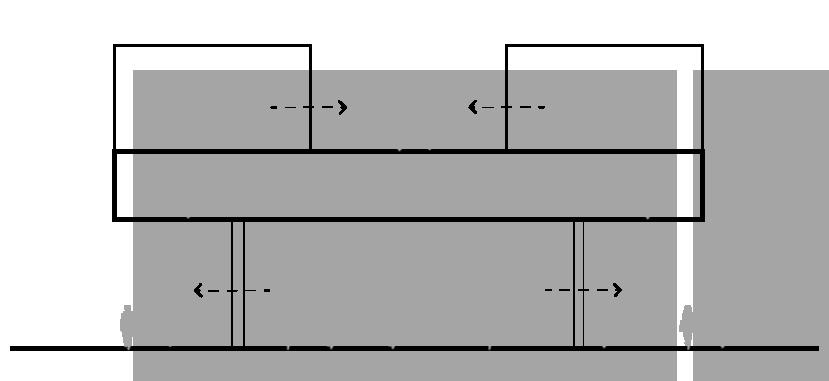
Commercial Offices & IT parks
Zoning Plan of the neighbourhood
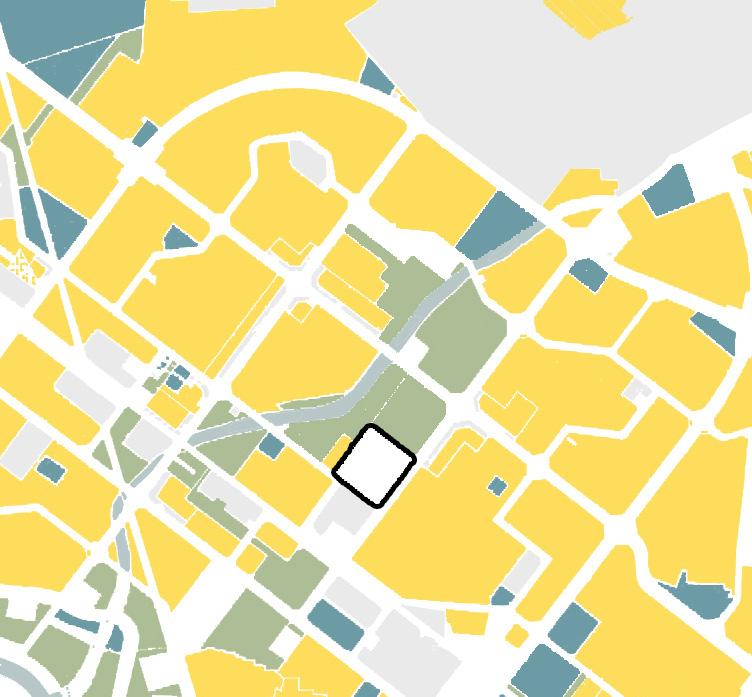
Third Place Site-Level response
Specialised Function
Specialised Function

Common public realm
Programmed & Programme free spaces

Inter-connected Building-Level response
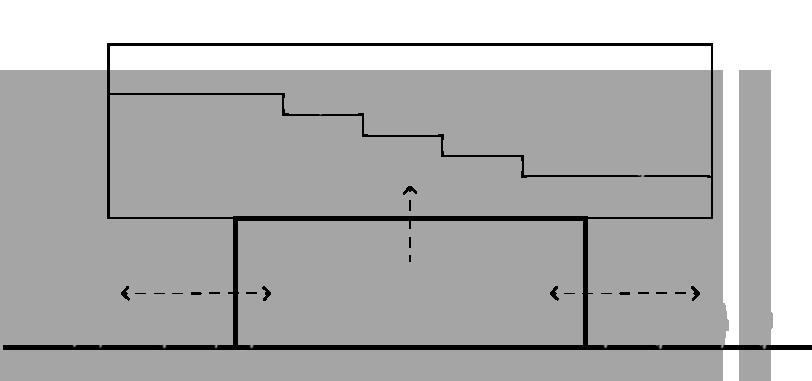
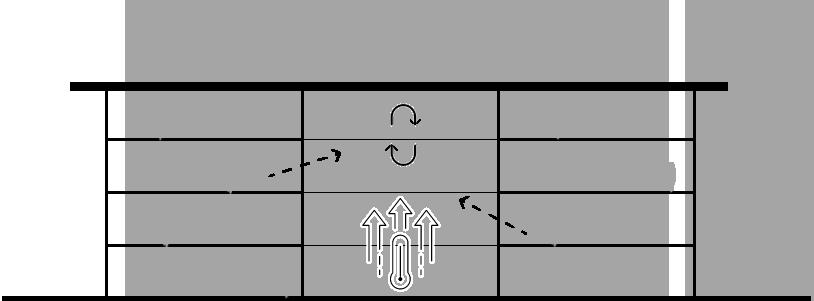

Atrium creates visual cross connections, but traps heat
School & Colleges, no common platform Need for a cultural & co-learning space
Self contained Residential societies with kids & elderly

+ +
Culture Center Expanded role of Public Library
+ Knowledge Center

Dissemination of Culture Special occasion
Creation of Culture Activated ground
Special events + Daily needs = Constant activation
Re-contextualised as a stilted courtyard, allowing for connection and circulation
8
Learning by Doing
Residences
Learning through Experience
Public Realm

General Library
Teen’s Library
Kids’ Library
Tuition Classes
Classrooms
Spillout Bridge
Co-working offices
Rooftop Amphitheatre
Auditorium
Dance & Music studio
Multi-Purpose Halls
Art Store
Art Gallery
Primary School
Learning through Interactions
Learning through exposure
 Metro Station
Office Hub
Metro Station
Office Hub
Shops & Retail Sports Complex
Isolated blocks

Prevents cross - learning and divides users into dedicated audiences
Under one roof yet disconnected Brings the users together, however due to floor divisions, they are unable to meet
Visually connected but The atrium allows for cross-connections but hinders user movement
Creating the ‘in between’ meeting spaces
Allowing spaces to flow into each other, the section creates volumetrically varying, collective meeting points. The visual connections intrigues new users to explore and learn organically

3 2 1 9 12 11 11 14 15 16 GATHERING & SHARING
URBAN LIVING ROOM
but restricted cross-connections movement across
floor
Surface as a space generator Profile creates connected outdoor spaces but loss in floor space & programmatic volume

Visually & Spatially connected
Without losing the built volume, allows for common spaces and spill out zones
 the
the
3.
4.
1. Cafe’ 2. Drop off
Entry
Visitor help desk
10.
11.
12.
5. Art Gallery 16.
6. 4 14 13 10 11 7 8 5 6 7 COLLABORATIVE WORKING GROUP STUDY ZONE CAFETERIA & LOUNGE
Restaurant
7.
Outdoor dining
8.
General Library
9. Digital Library
Kids’ Library
Balcony
Multi-media library
13. Teen’s Library
14.
Co-working space
15.
Stepped atrium
Hot-desking zone


12 Ground level plan Meandering experiences
2 3 3 4 4 4 4 4 4 4 5 5 5 5 6 16 16 6 15 11 9 10 9 13 12 14 7 7 8 14 1 1 1 2
Upper level plan Library as connector
1. Pedestrian Entry
2. Vehicular Entry
3. Info. Center
4. Retail
5. Cafe’
6. Multi-purpose Hall
7. Dance Studios
8. Library living room
9. Kid’s Library
10. Teen’s Library
11. General Library
12. Public Bridge
13. Classrooms
14. Art Gallery
15. Auditorium
16. Event lawns
Visually inter-connected spaces encouraging explorations

 Bridges fostering cross connections & dialogue
Bridges fostering cross connections & dialogue
CAN VACANT ROOFTOPS FACILITATE URBAN HOUSING?
Adaptive reuse of ordinary spaces can be a way of not only building sustainably, but also make the most of the existing resources, thereby making it an affordable strategy.
Rapid urbanism, limited availability of land and rising property prices, have led to a major housing deficit in our cities making them increasingly unaffordable specially for the young working professionals and students. As a young graduate myself, I faced the similar issue and started noticing that there was no specific real estate typology catering to this user group. Most people share and rent larger apartments, which are designed for families, and are unable to cater to their dynamic, specific user requirements.
Rooftops are a dimension which constitute a large piece of urban infrastructure, but remain largely, under utilized. By hosting lightweight additions, this project proposes an alternative for demolition and simultaneously creating affordable dwellings. The design aims at creating flexible, multi-purpose spaces facilitated with daylight, insulation and outdoor connections.
With a deep interest in designing small spaces, this project allowed me to explore the potential of tiny houses to become not only a luxury escape but a solution for healthy, comfortable and affordable urban living.
14
Re-imagining tiny living for young professionals
Personal Project 2020
Bangalore
Competition Entry Volume Zero : Tiny house competition Area 27 sqm | 290 sqft
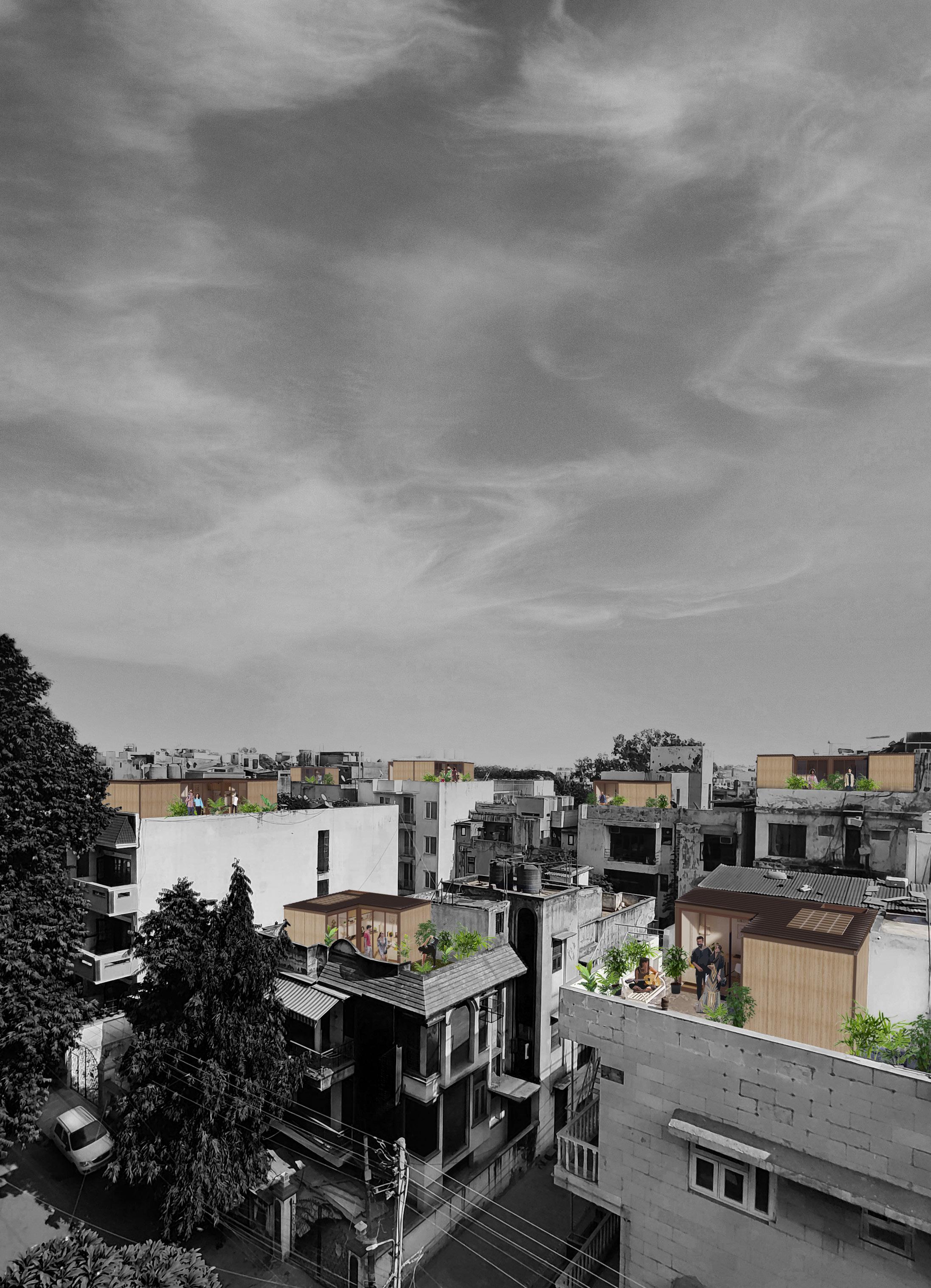

Circular in nature, Modular by design
Designed as lightweight additions, the units are made up of prefabricated components, allowing for easy assembly & disassembly
Plug & Play
Building upon ‘rented spaces’ & utilizing existing site services, to minimize costs
TOILET
KITCHEN LIVING SLEEPING DECK
Separate Zones
Distinct spaces created within the tight footprint creating different experiences
Flat Pack
Allows for installation & removal without heavy machinery, leaving the site in its original condition
Daylight & Flow
Enhancing indoor-outdoor usability & natural daylight in all spaces
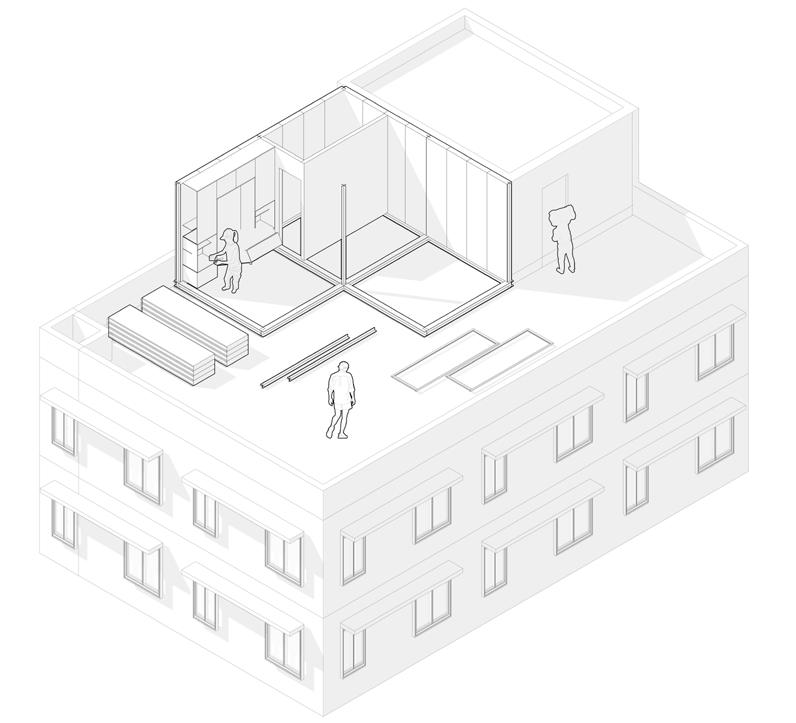

Lightweight construction
Made up of CLT panels, reduces the added load on existing structures
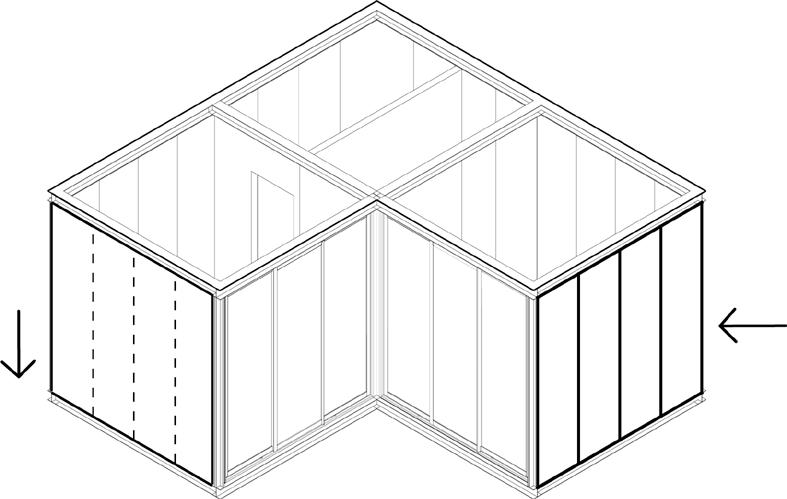
Expandable design
Modular structure grid allows for multidirectional extensions


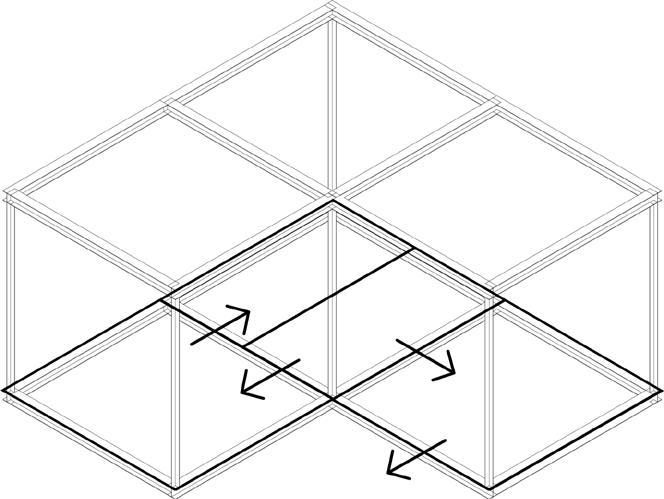
16
 5. Skylight
2. Metal seamed roof
4. Steel structural framework
5. Skylight
2. Metal seamed roof
4. Steel structural framework
1 2 3 4 5 5 6 8 7 7
1. CLT Wall Panels
7. Retractable Furniture
3. Aluminium Sliding Panels
6. Kitchen Island
8. Movable Desk Providing daylight, ventilation & quicker drying in bathroom
Allows for integration of domestic solar panel Prefabricated ‘I-sections’ bolted together to form the structure Lightweight, insulated walls serving as structure & finish
Hidden storage & bed unit, creates space for multiple uses
9 ft high glazing, allowing natural daylighting for entire floor plate
Concealed storage with Washing Machine
Movable workspace capable of serving as dining table
Same place, Multiple spaces
Adapting to the changing needs of the users throughout the day, the spaces serve multiple functions and transform their character

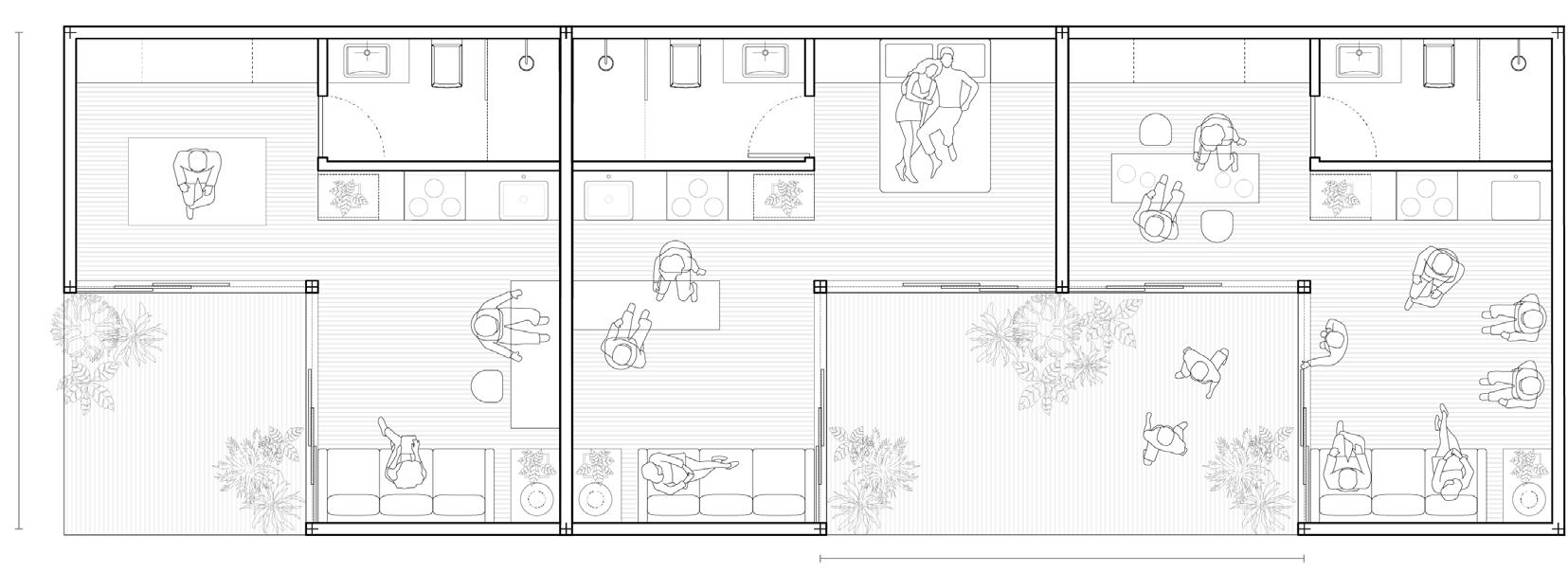


3000mm
Morning Sleeping | Cooking | Lounging
Daytime Work from Home | Reading | Yoga
Quiet Evenings
Cooking | Dining | Sleeping
Entertaining Nights
Food & Beverages | Talking & Lounging
6000mm
Scalable design
Still ensuring daylight & outdoor spaces for each unit

18
3000mm 6000mm
Connected spaces yet Separated zones


Allowing for change of space and varying user experiences
Restricted physical space, Expanded mental space
The bedroom opens to the deck, while kitchen chaos remains out of sight
Professional Project
CAN A HOUSE ‘GROW’ ALONGSIDE A GROWING FAMILY?
Building upon the built
Jangpura, Delhi
This project gave me a chance to translate the idea of rooftop extensions into built practice and develop the concept further by incorporating structure and services. It also exposed me to the legalities and economics involved with adaptive reuse.
A growing feature in contemporary Indian society is a desire to live urban, nuclear lives, but remain connected as a traditional, large family. Coupled with the problem of limited unbuilt parcels of land in the city, reviving existing houses to accommodate new familial changes can help build sustainably and preserve the associated memories.
With a desire to lead such an independent yet connected life, a young family was looking for a new house. We proposed building on top of the ancestral house, where the father had grown up as a child himself - thereby retaining a home for the grandparents and an independent dwelling for the young family.
Highlighting this approach, the project proposed a lightweight metal and timber addition with a dry wall system, to create a warm abode in the middle of urban life. It incorporated changing volumes and carved out indoor-outdoor connections within the tight footprint. Designed during the pandemic, the entire house was made up of kit-of-parts, to minimize the work on-site.
Project Role
Concept Design | Design development and detailing | Presentations
Project Team
Studio Lotus : Ambrish Arora | Ansel Colaco | Adil Hussain
Status
Sanctioning
20
2021

Structural analysis of the existing house was undertaken and temporary additions were dismantled


Lightweight steel structure, integrated with services, was designed like a kit-of-parts using standard member sizes allowing for quicker construction
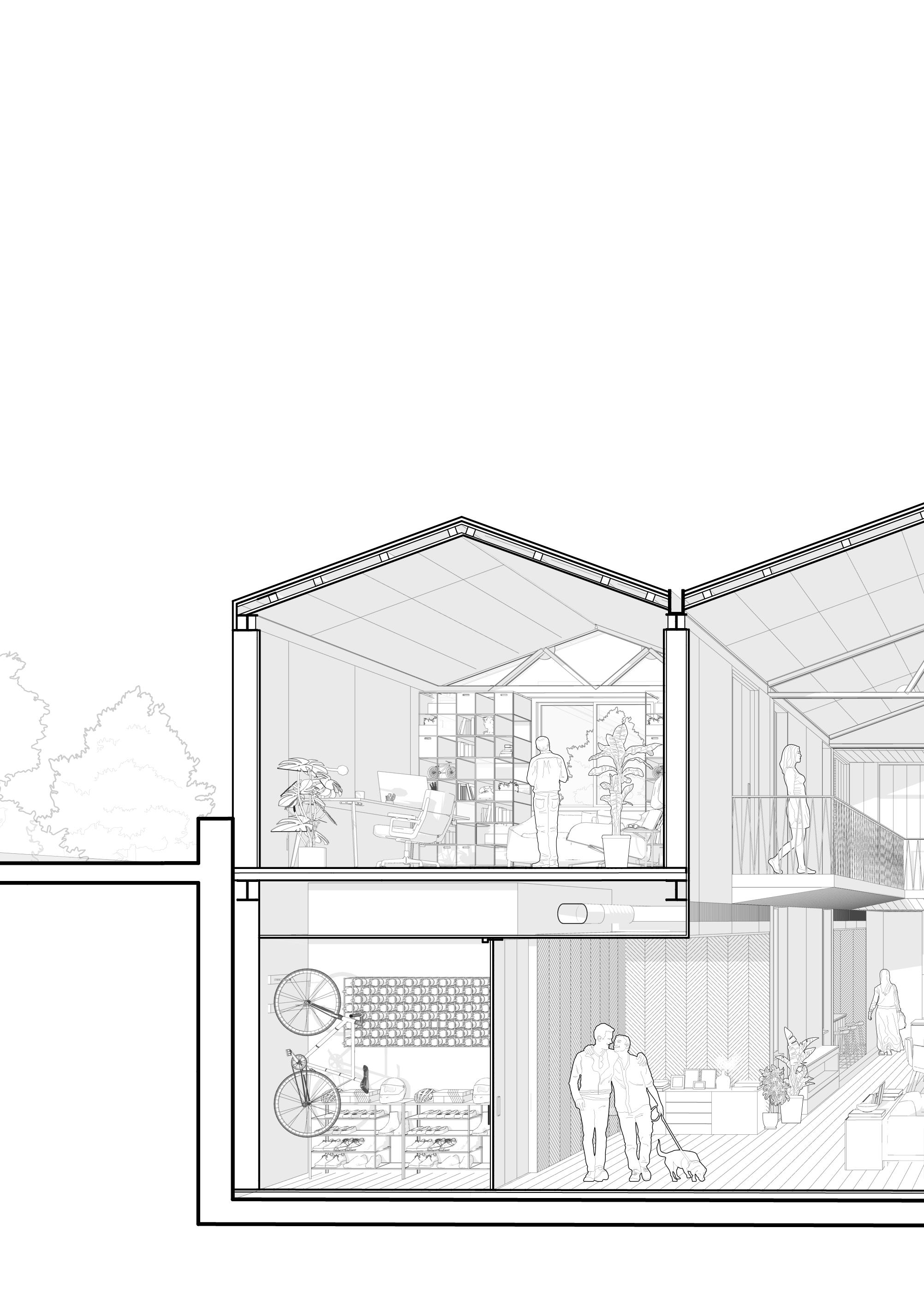
5.
6.
7.
8.
9. Kids’
10.
11.
12. Utilities 13.
services 2 1 12 13 9 10 11 7
1. Entrance Vestibule 2. Storage 3. Living Space
4.
Terrace with Pergola
Dining
Open kitchen
Bar nook
Parent’s bedroom
bedroom
Study/Home office
Light well court
Concealed
Balconies were carved out to provide outdoor connections. To reduce site work, a modular cement board wall system was designed for the facade


The roofs were split to frame vistas, informed from the interior user experience. The truss was made up of metal plates & timber infills

3 5 6 8 4
Fluid floor plan with connected outdoor spaces, facilitated a larger sense of living. Changing volumes - larger for collective gathering, smaller for bedrooms creating intimate spaces, generated range of user experiences.
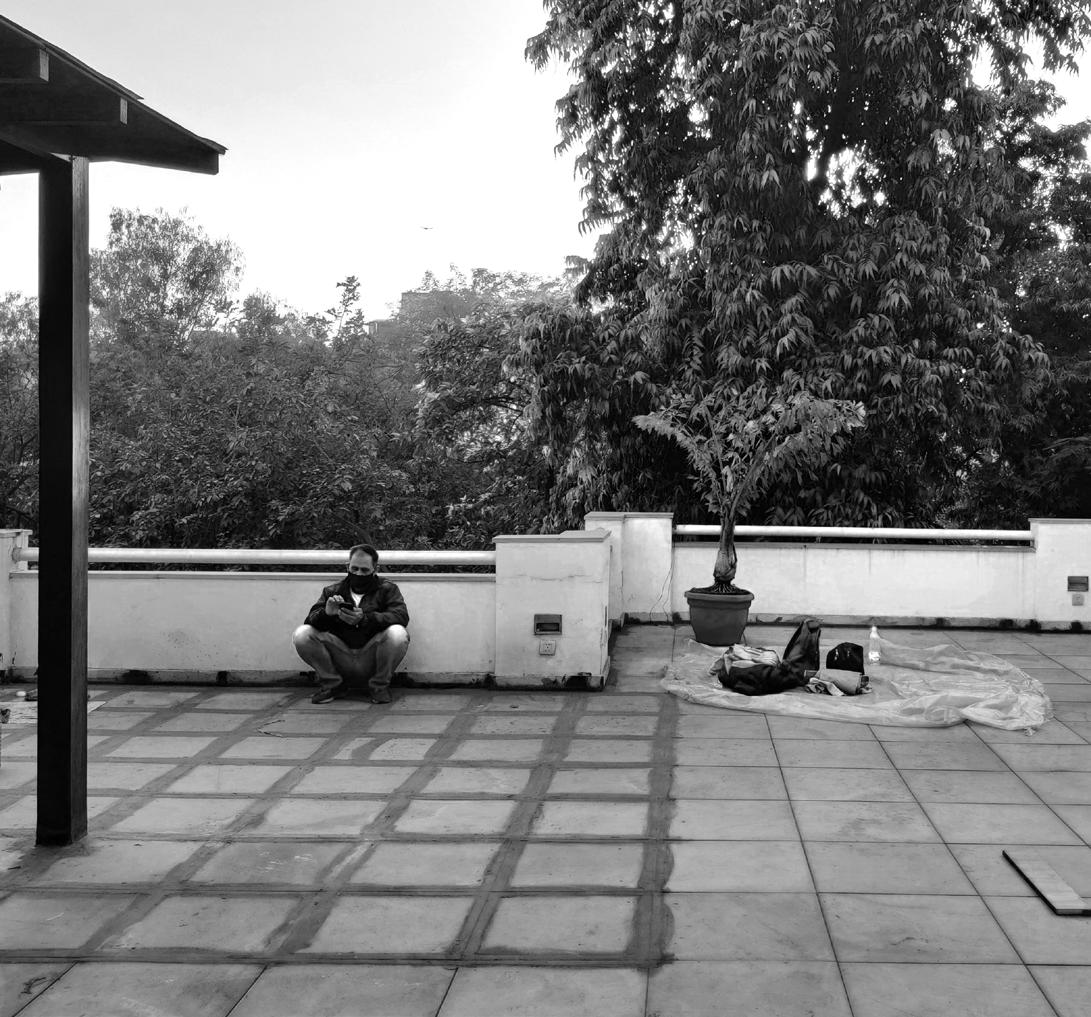


Current Condition
Entry Experience
24 1 2 3 11 10 12
Facing a primary busy road, views were framed strategically



Entrance
1.
Shaded Deck
2.
Living
3.
Space
Dining
Open kitchen
Bar nook 4 5 6 7 8 12 9 10 Current Condition
4.
5.
6.
Living Experience
Pantry and Utilities
Facing the adjacent park, thereby providing unhindered light & future views
7.
Kids’
8.
bedroom
9. Recreation space
10. Light well court
11.
Study/Home office
12. Balcony
HOW TO BUILD, WITHOUT COMPETING, WITHIN A FORT?
Building within a historical context is a challenging task especially, in Jodhpur, Rajasthan, as history is a living, daily reality. The building fabric has developed over multiple centuries and continues to interact and grow with the contemporary needs of society.
The project is a new intervention within the Mehrangarh fort, a 15th-century palace turned museum and one of the most visited tourist destinations. To facilitate the contemporary role of the fort, an ambitious ‘Knowledge Center’, containing an art conservation facility, research library, and conference hall, was proposed.
Since available land within the fort walls is becoming scarce over the years, the proposed building was located in a ‘ditch’ between the fort walls and the adjoining Chokelao palace. The design was envisioned as an extension of the ground plane and instead of building above, was imagined to be a labyrinth below the ground - merging within the fort instead of competing against it.
Initially a competition, I joined the project right after the commission was won and was involved in the design development of the proposal. Synthesizing site conditions, changing public programs and services alongside design, was a great learning in translating ideas into built form within a sensitive context.
Project Role
Design development and detailing | Presentations | Construction drawings
Project Team
Studio Lotus : Ansel Colaco | Adil Hussain
Status
Under Construction
26
Professional Project 2021
Creating the ‘Knowledge Center’ in Mehrangarh Fort
Jodhpur, Rajasthan
 Drawn in collaboration with Prajwal Amin & Jatin Khandelwal
Drawn in collaboration with Prajwal Amin & Jatin Khandelwal
Inverted Building
Instead of building ground up, the new intervention was designed within a ditch, to minimize the visual interference, allowing for seamless integration with the existing ground and creation of an extended public plaza.
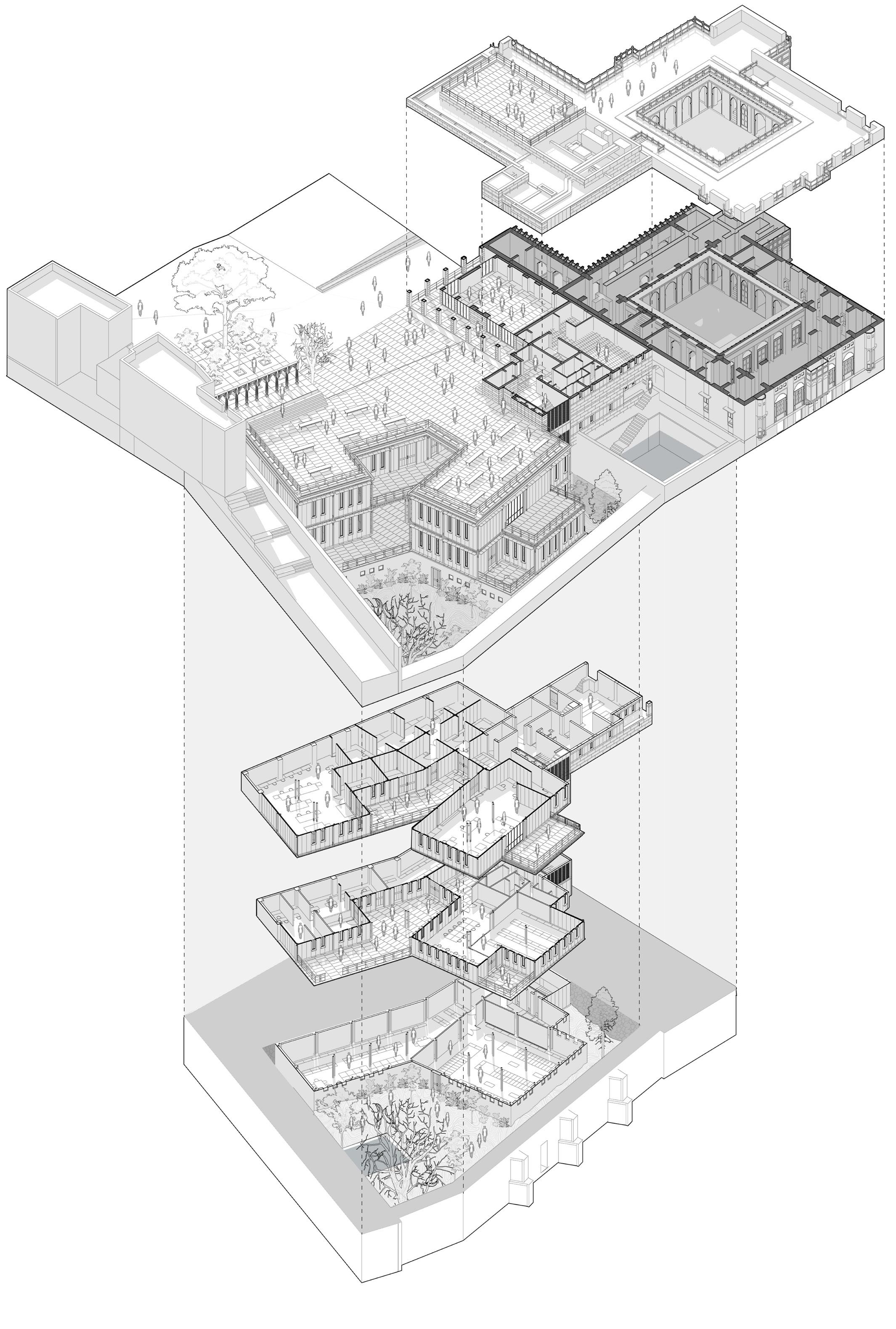
28 1 2 3 4 5 6 8 9 11 11 22 12 12 13 14 14 14 24 26 25 17 15 16 18 19 20 7 7
1. Existing Palace
2. Restored Arches
3. Existing Step-well
4. Public plaza
5. Foyer
6. Conference Hall
7. Rooftop Restaurant
8. Reception
9. Washrooms
10. Lift
11. Kitchen
12. Art Conservation Lab
13. Documentation Studio
14. Materials Library 15. Artifact Workshop 16. Research office 17. Director’s office 18. Reading room
19. Public Library 20. Balcony 21. Staff cafe’ 22. Server room
23.
Battery room
24.
Public terrace
25.
Water reservoir 26. Landscape garden


21 9 23 22 24 25 26 5 14 16 16 17 18 19 20 10 1 1 1 2 5 8 10 3 4 24 20 26 3 11 9 6 Entry Level Plan Conference & Kitchen block Library & Research Offices Level -2 Plan
Site specific Design Guides
An important mandate was matching the datum lines of the existing fort wall adjacent to the conference block. Since the intervention was visible from the main fort, the rooftop became another visible & vital experience.
Hybrid Structural System


The conference block was built as adaptive reuse of the existing garage structure, abutting the fort wall, and thus designed in RCC. To keep the additional foundations shallow, lightweight metal framework was used for designing the new labs.
1. 100 x 100 mm MS Box sections
2. Connecting Plate forming a 300mm column

3. MS beams welded to form connectors
4. Half-lap cut MS beam with bolted connection
30
3 4 4 5 2 2 1 1 3
5. MS Plate stiffeners
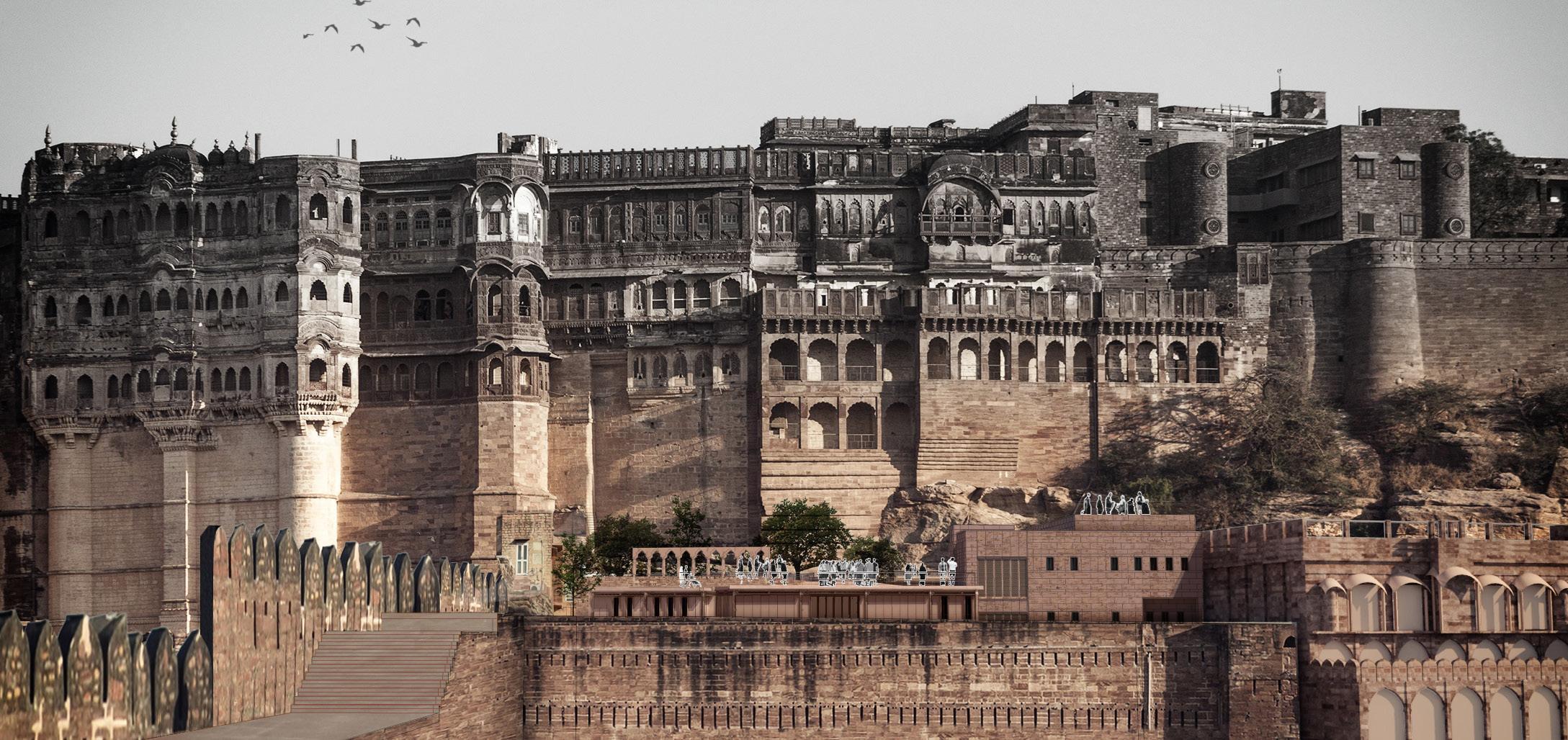
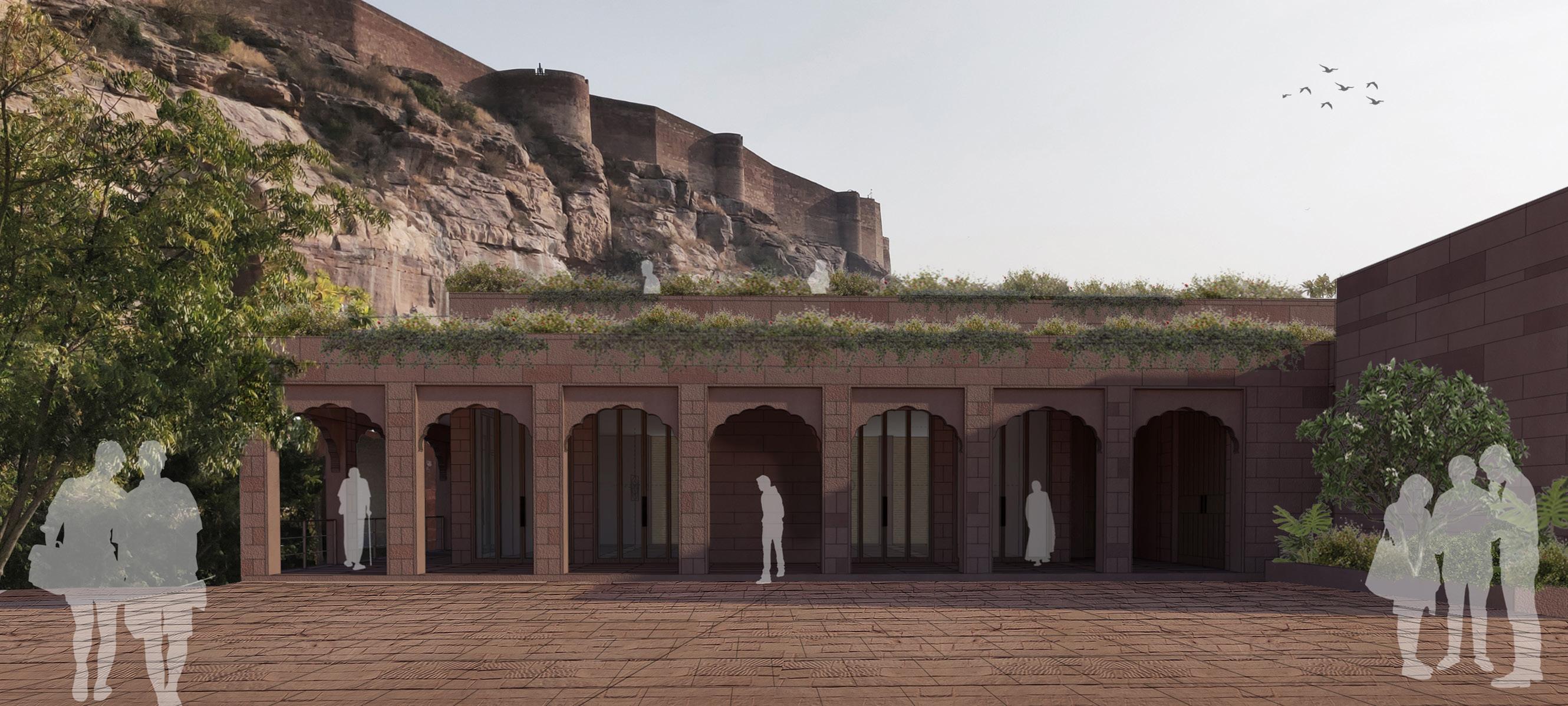

Merging quietly within the Context Creating a world of it’s own within
Proposed Design Conference hall & public plaza
Existing Condition Stables turned into parking garages
HOW TO BREATHE NEW LIFE INTO AN
EXISTING PLACE
Reviving an old house into a hospitality experience
Professional Project 2022 Matial, Uttarakhand
An intervention within a historic building itself, the project looked to revive an old structure belonging to the colonial era of British India. Originally built as a bakery, this stone structure was retrofitted post-independence, as a home by the local village chief.
However, today the building faced many challenges, structurally and experientially. Due to poor insulation, it remained sparsely occupied throughout the year. The rooms added in the tall, central volume remained cut off from views or sunlight, making them cold and intimidating. The living space, due to its linear arrangement, created dead pockets and restricted interaction with the beautiful hills outside.
In order to revive its occupancy, and allow more people to enjoy this experience, the building was re-imagined as a rentable hospitality suite. The design focused on enhancing the experience of the occupants while celebrating the present building in all its truth and glory.
Being the ‘Project Architect’, this was a fascinating learning in adaptive reuse. Apart from the technical challenges of intersecting new and old structures, it led to interesting questions of overlapping narratives and implications of retention or change.
Project Role
Concept Design | Design Development | Site co-ordination
Project Team
Studio Lotus : Ambrish Arora | Ansel Colaco
Status
Construction drawing
32


Design Current Condition
Proposed
Adapted as an old house, the bedrooms were currently located in the central higher volume. This made it cold and intimidating experience, without direct sunlight or connection with views outside.
The central, larger volume was re-designed to host inter-connected public spaces. The side flanks, with a lower volume, were redesigned as cozy, intimate bedrooms with framed views of the mountains.

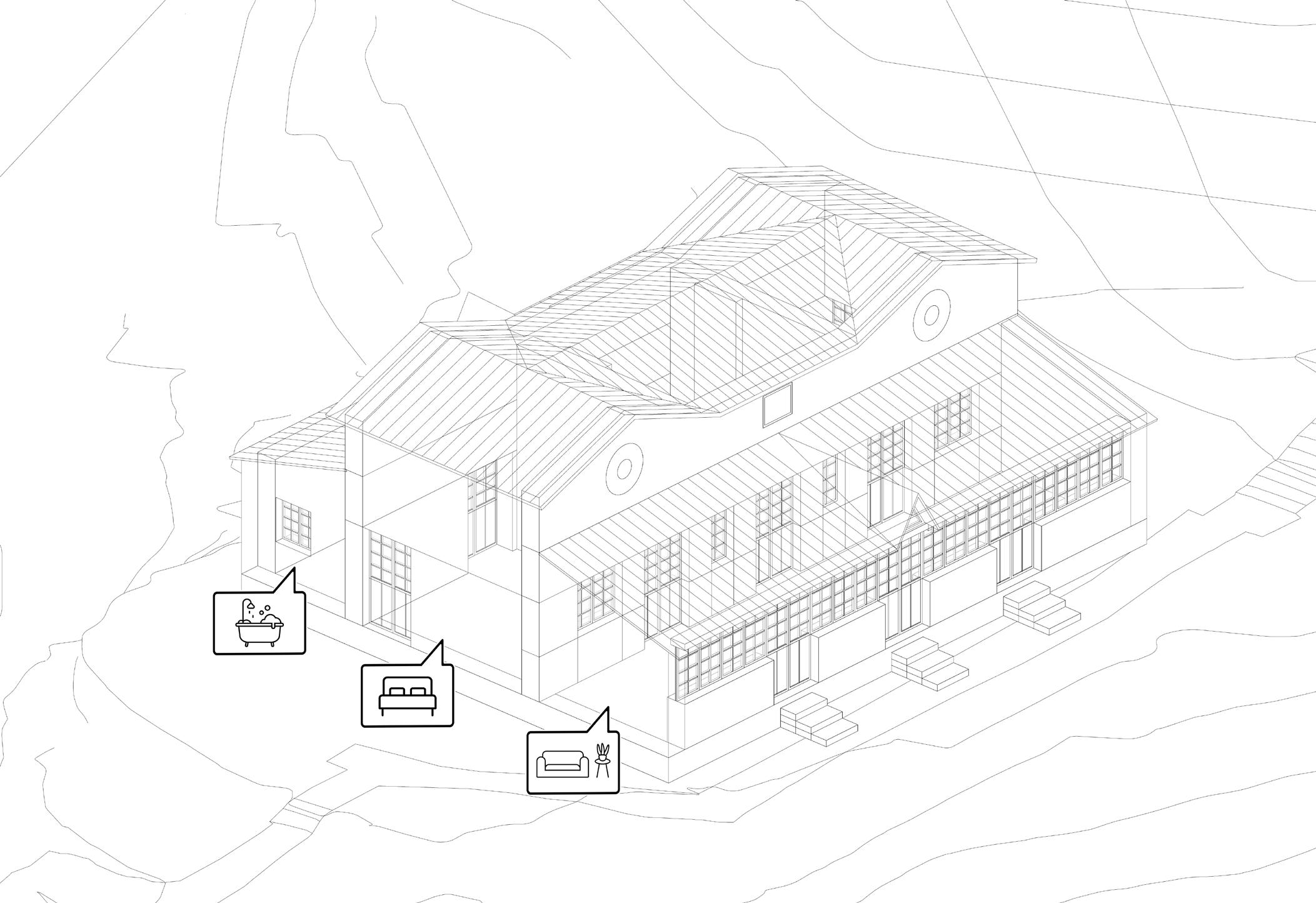
34

 1. Entrance Foyer
1. Entrance Foyer
7.
8.
1 2 3 4 4 4 5 5 6 7 8
2. Living space 3. Pool table 4. Bedroom
5. Bathroom 6. Outdoor
deck
Lawn
Vehicular drop-off
1. Entrance Foyer
2. Open Kitchen
3. Dining table
6.
7. Bathroom 8. Lawn 9.
1 5 5 5 5 6 6 7 7 7 7 6 6 3 2 4 8 8 9
4. Conservatory Living 5. Bedroom
Outdoor deck
Vehicular drop-off
Sequence Interventionof



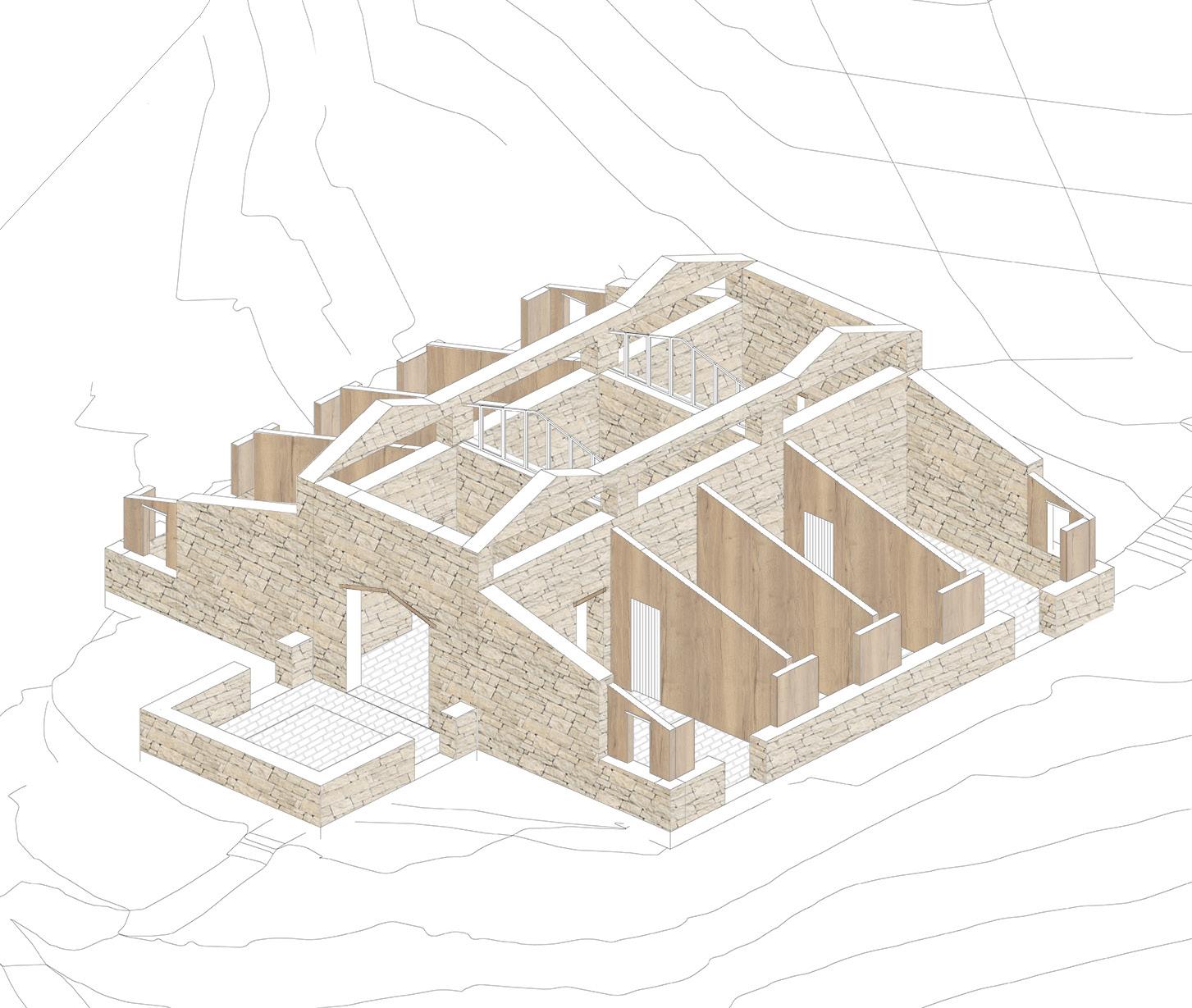

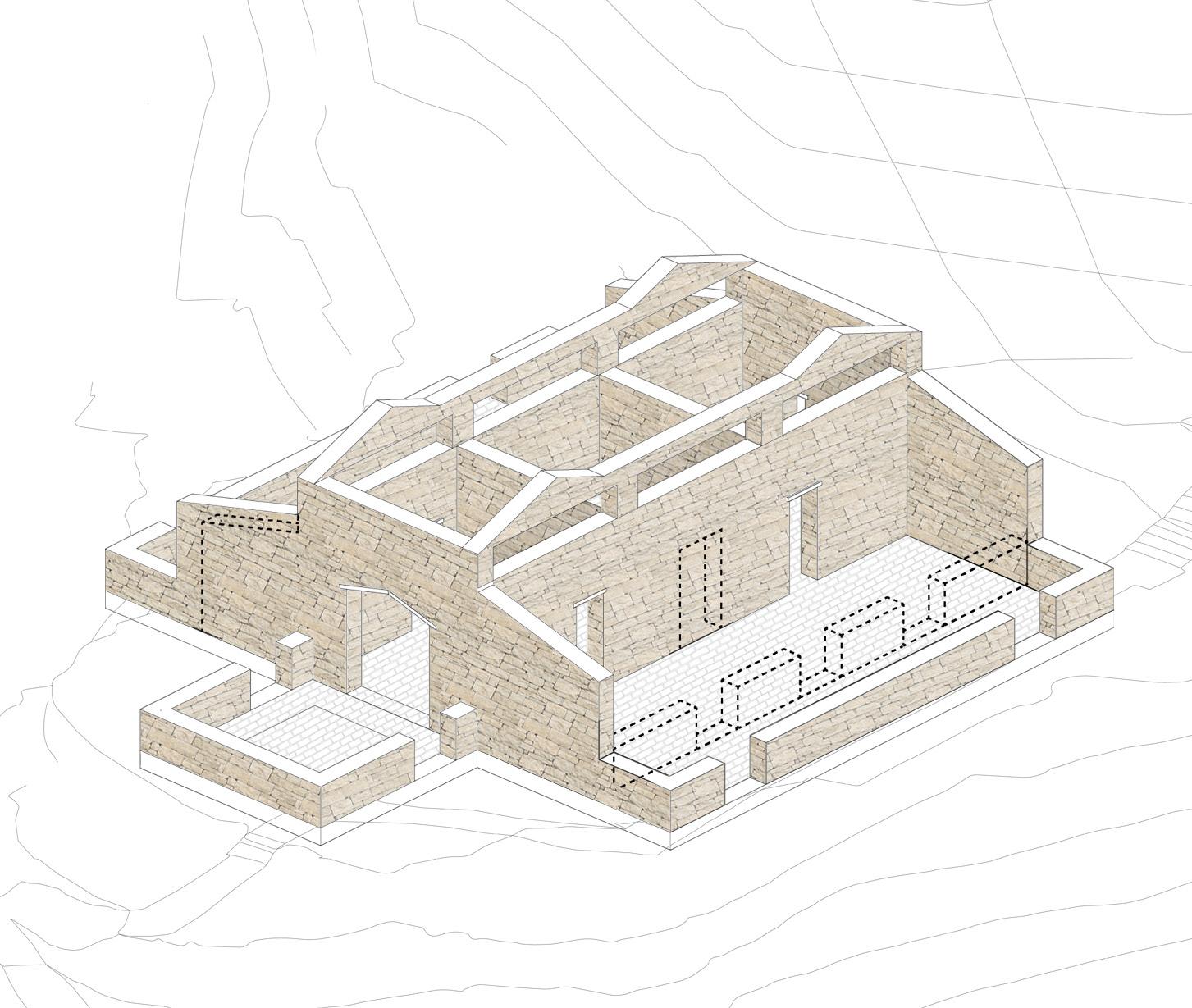
36
Documentation & Analysis of existing building
Plinth Extension & Stone wall additions Insulated glazing & Flooring installation
Demolition of leaking roof & aging timber
Timber dry-wall room partitions & facade
Roof rafters restored with insulated sheeting
Existing Condition
Proposed Extension

Capturing views & sun across the day
 Paint chipped to highlight stone masonry
Paint chipped to highlight stone masonry
Professional Project
2022
WHERE CAN ‘VERNACULAR’ & ‘CONTEMPORARY’ MEET?
Matial, Uttarakhand
Building a contemporary resort within the serene hills of Uttarakhand, posed an interesting challenge. On one hand, in an attempt to create authentic user experiences, our team looked to create a design informed by the context. While on the other hand, we became aware of the reality that ‘local materials’ themselves are becoming scarce and instead of mining further, require conservation.
Vernacular knowledge systems are a great lesson in building in sync with the cultural and ecological context. In the hilly Himalayan region, the local architecture is known as ‘Kath Kuni’ construction - which involves the use of timber and stone to create interlocking load-bearing walls.
But in the absence of these materials, we relied on careful re-interpretation. We studied the local scale and form, to create humble spaces. The project looked to re-examine the idea of luxury in hospitality by prioritizing connection with nature instead of grand gestures. Instead of mining for stone walls, we used stone obtained from the excavation to develop hybrid wall sections. Instead of timber bands, we used glulam to create a lightweight timber roof structure and reclaimed wood as facade shingles.
As the ‘Project Architect’ of the ‘Public Building’, seeing the project from concept to construction, allowed me to learn and collaborate with various people - from expert consultants to masons on site.
Project Role
Concept Explorations | Design Development | Construction administration
Project Team
Studio Lotus : Ambrish Arora | Ansel Colaco | Mohit Goel
Status
Construction
38
RAAS Devanya - A retreat in the hills
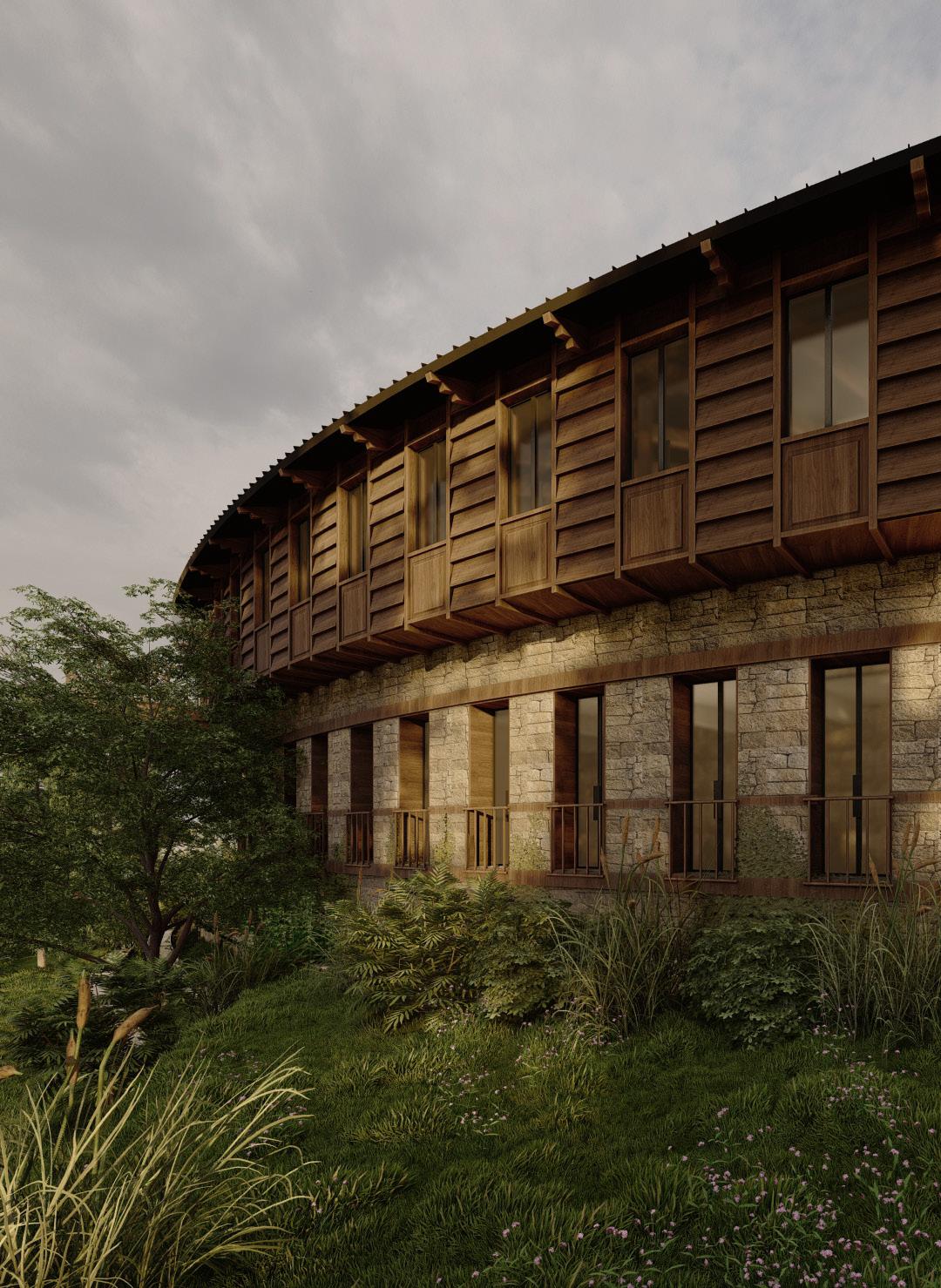
Evolution of building programme & resulting form
Building along the contour Maximising the views
Programme expansion
Pool incorporated to minimize built
Served and serving spaces
Incorporating ‘Back of House’
Recreating the mountain village, the Public building caters to 20 keys & supporting services Overall Site Plan
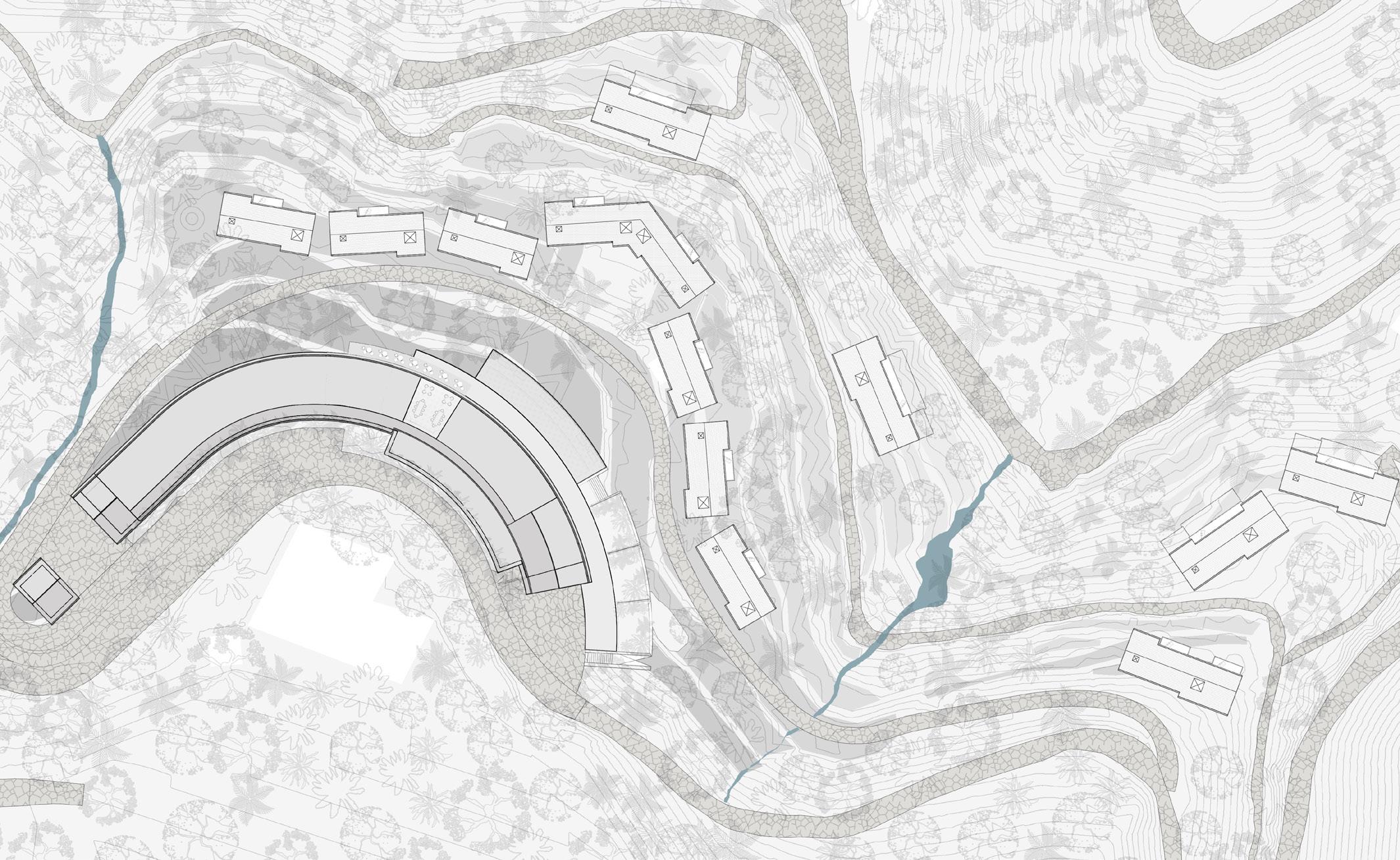
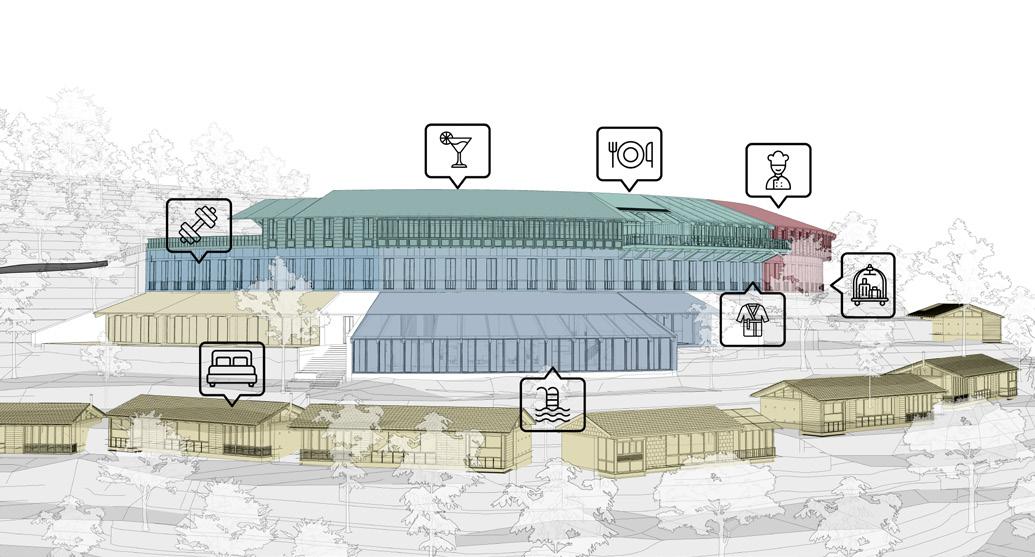
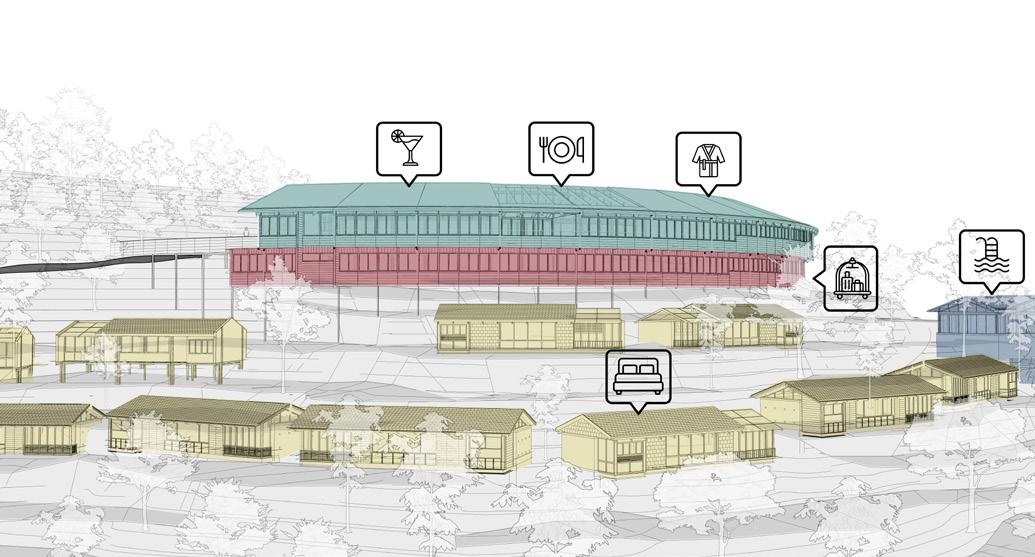

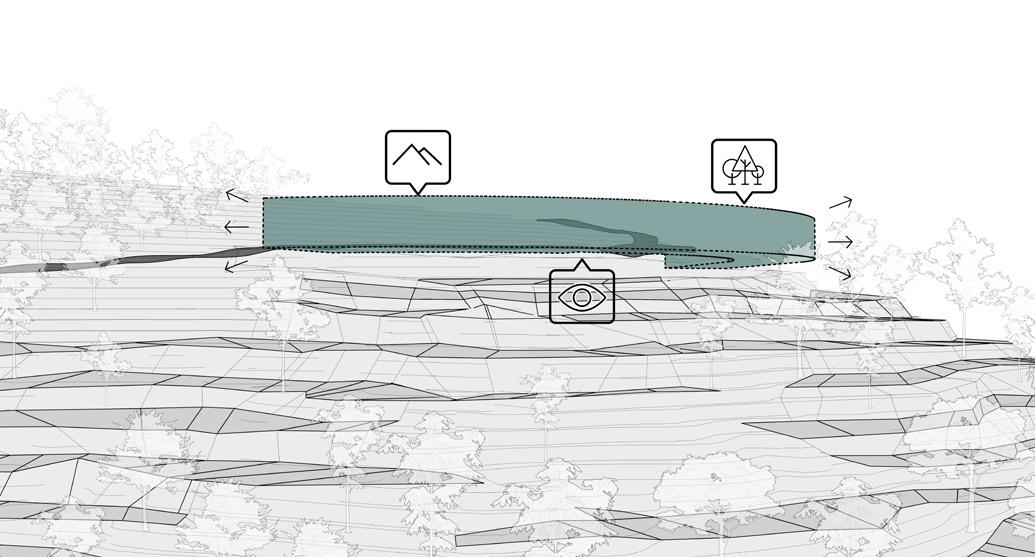
Programme consolidation
Universally accessible rooms added
40
Entry 1 2 3 4 5 6 7 8 9 10 11 14-13 12 15-16
19-20
17-18
Challenges of recreating the past
Despite lack of ‘local materials’, informed the design by studying vernacular form & construction


Traditional vocabulary, contemporary material application
Cantilevering entry level structure was designed using Glulam, while stone from excavation were used in walls
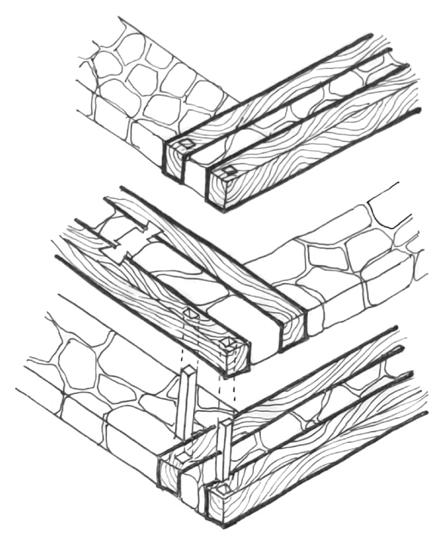

Concrete Retaining wall + Framed structure + Stone walls
 Vernacular Section Heavy base & Cantilevering top
Interlocking Wood & Stone Kath-kuni construction
Section Iterations exploring User experiences
Metal columns & rafters Services
Glulam Timber columns & rafters
Vernacular Section Heavy base & Cantilevering top
Interlocking Wood & Stone Kath-kuni construction
Section Iterations exploring User experiences
Metal columns & rafters Services
Glulam Timber columns & rafters
Re-interpreting vernacular form with contemporary program
Creating an intimate scale, the section was designed in steps to work with the contour instead of against them.
At any given moment, the user thus experiences a single story space, making it more homely instead of an intimidating experience
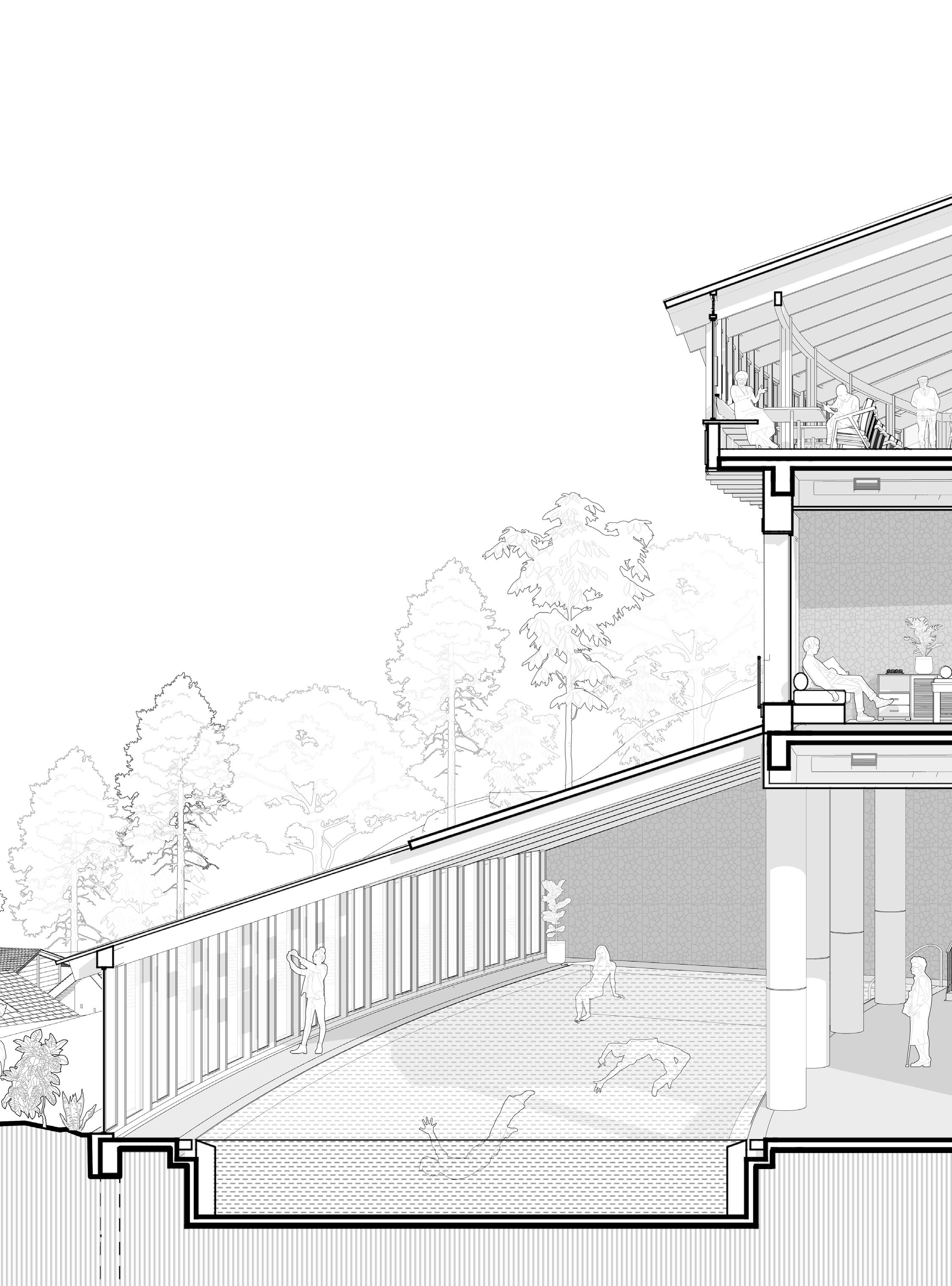
42
8 9 10
 1. Reception
2. Bar & Lounge
3. Pool & smoke
4. Spa rooms
5. Gym & Games
6. Staircase
7. Room corridor
8. Pool deck
9. Heated pool
10. Landscape deck
11. Underfloor heating
12. MEP Services
13. Retaining wall passage
1. Reception
2. Bar & Lounge
3. Pool & smoke
4. Spa rooms
5. Gym & Games
6. Staircase
7. Room corridor
8. Pool deck
9. Heated pool
10. Landscape deck
11. Underfloor heating
12. MEP Services
13. Retaining wall passage
1 4 5 6 7 11 12 13 14 2 3
14. Entry level road


44 1. Drop off 2. Entry 3. Mudroom 4. Reception 5. General Manager 6. Bar 7. Living room lounge 8. Smoking zone 9. Library 10. Toilets 11. Al fresco dining 12. Outdoor dining 13. All Day dining 14. Kitchen 15. BOH services 16. BOH stores 17. BOH entry 18. Loading dock 19. MEP room 1. Games room
Gym 3. Spa reception 4. Change rooms 5. Relaxation lounge 6. Spa room 7. Couple’s spa room 8. Therapist room 9. Doctor’s room 10. Services 11. BOH offices 12. Staff washrooms 13. Staff cafeteria 14. MEP services 15. Circulation 1 1 2 3 4 8 5 9 10 6 6 6 6 7 11 13 12 14 15 2 3 4 5 6 8 9 11 13 12 14 15 16 17 18 19 10 7 Entry Level Plan -1 Level Plan
2.


Overall Building Form
Entry Experience
Merging vernacular material with contemporary energy-efficient standards

Working with the stone locally excavated during the process of digging foundations, various wall sections were devised to incorporate insulation within traditional materials to result in ecologically high performing facade system
19.
20.
21.
22.
23.
24.
25.
26.
27.
46
1. VM Zinc seam roof sheet
2.18mm plyboard
3. Vapour Barrier
4. Purlins & Rockwool Insulation
5. Planked timber ceiling
6. Glulam truss
7. Clerestory window for south light
8. Glazing
1 2 3 4 5 6 7 8 9 13 14 15 16 17 18 14 15 19 25 26 27 24 22 21 20 23 12 10 11
9. Slate stone coping
10. Metal cross column
11. Timber infill member
12. Retaining wall
13. Drainage channel
14. 150mm thk. Stone Masonry
15. 75mm thk. Insulation board
16. 225mm thk. AAC block with plaster
17. Concrete lintel
18. Timber lintel
225mm thk. Stone Masonry
Glulam beam
Timber mullions
L.G.S.F drywall system
Timber framework
Timber shingles
Timber jamb
Openable insulated windows
Timber railing fixed to the


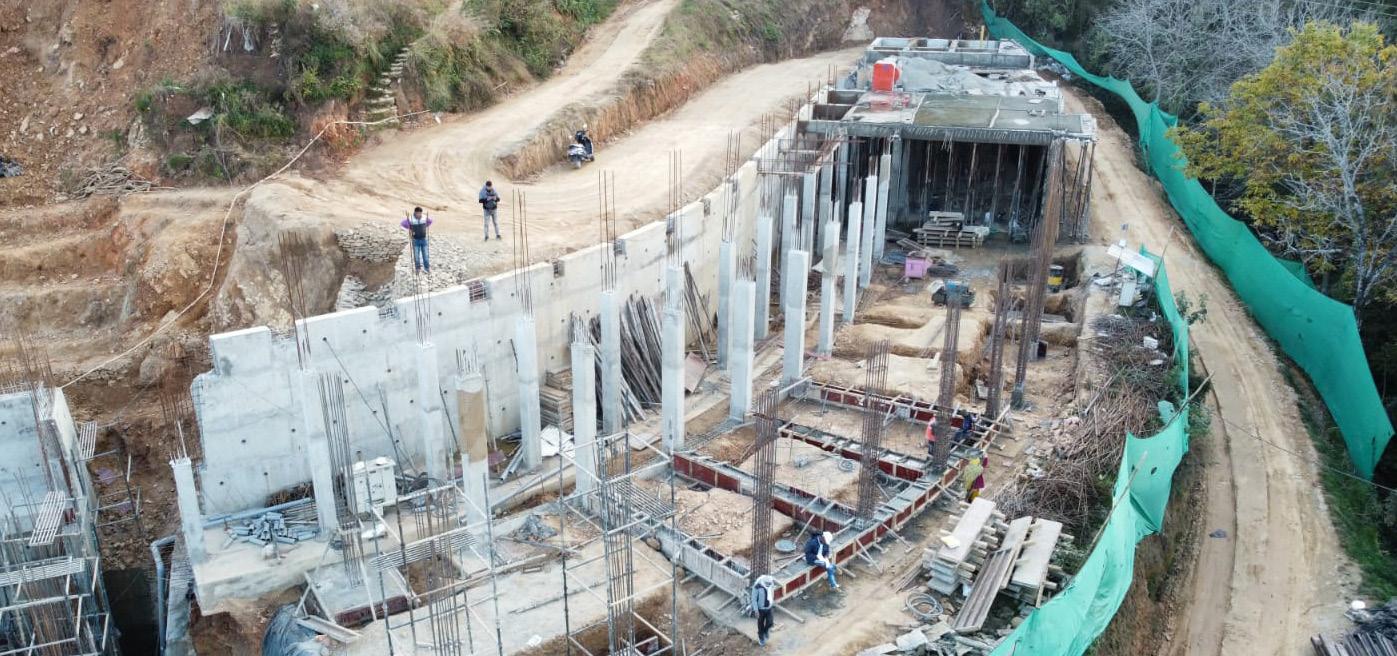
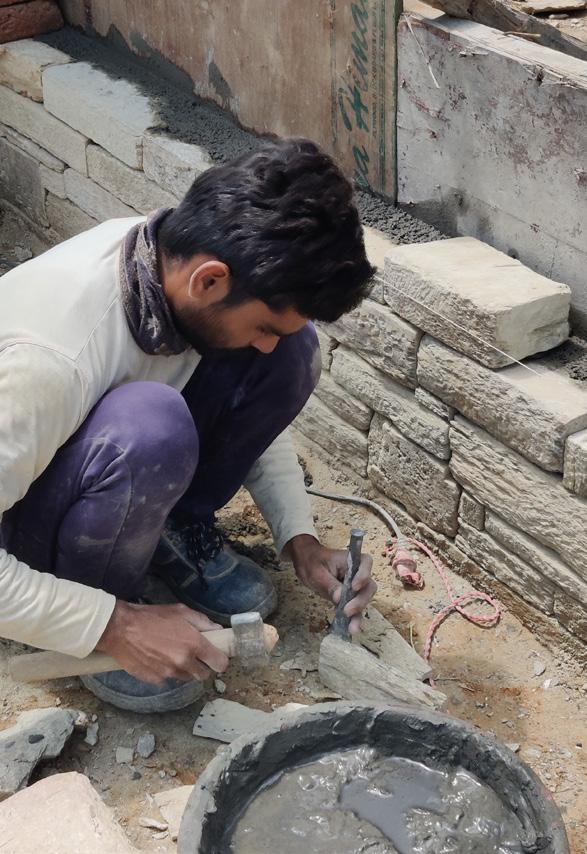
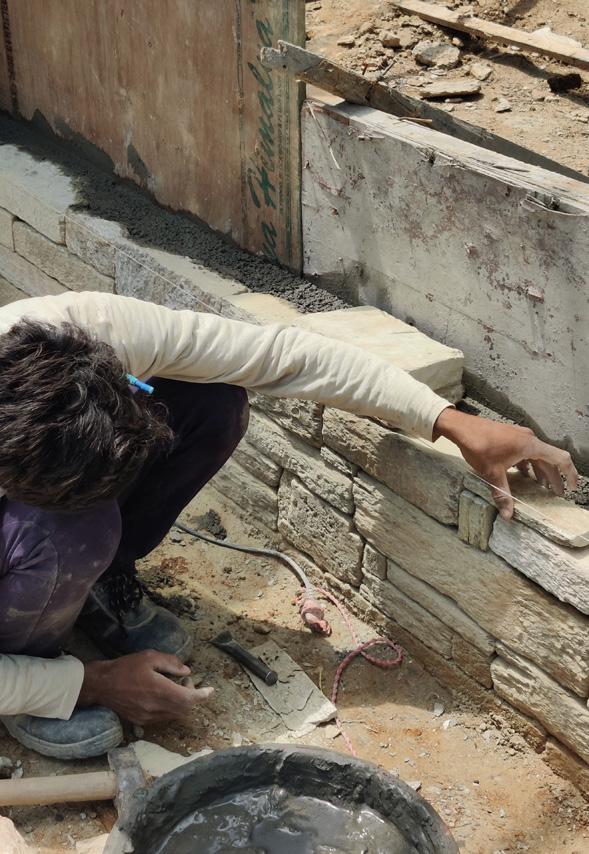
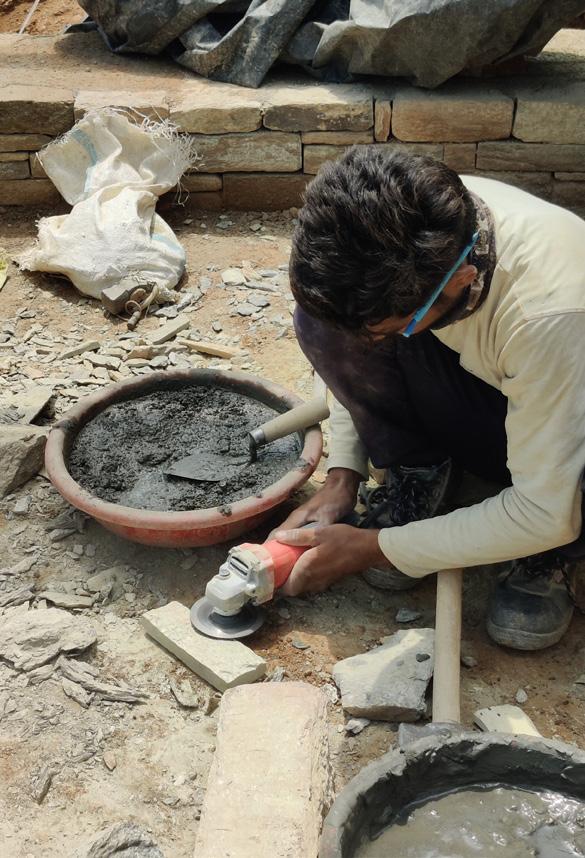
CAN PRIVATE TOWERS AND PUBLIC PARKS COEXIST?
Urban Redevelopment of an existing neighbourhood
Academic Project 2019 Janakpuri, Delhi
Developing upon the ideas of revitalization and activation of public spaces, this project looked at the problem at an urban scale through the redevelopment of a mixed-use neighborhood in Delhi.
With the increasing population in our cities, there is a rising demand for the densification of existing built fabric. But development driven by capital often results in different user experiences for different classes. Being connected with natural, open spaces is becoming a privilege within a congested urban city. The proposal thus aimed at recognizing the existing, central park as a critical resource and extending it to everyone - within and beyond the site.
The scheme was driven to create a pedestrian-friendly precinct, capable of inviting and connecting with the larger networks adjacent to it. Apart from housing, it provided supporting amenities such as offices, retail and recreational facilities to create a thriving and inter-connected urban living experience. An elevated podium loop enhanced the common public spaces.
All the spaces, from the hotel to low-income housing, were visually treated with similar attention and aesthetic, to erase the biased divide between different zones and create a unified neighborhood.
Project Role
Site Analysis | Concept Design | Design Detailing | Model making
Project Team
Anam Nasim | Sharon Sabu | Veeresh Angiras
48
 Made in collaboration with Anam Nasim, Sharon Sabu, Veeresh Angiras
Made in collaboration with Anam Nasim, Sharon Sabu, Veeresh Angiras
Current Zoning
A largely residential neighborhood, the current site hosts a commercial market, temple & schools nearby
Mobility structure
The site is flanked by a major road network and also accessible by city-wide metro railway
Potential network of greens
Although there are many parks, they remain restricted, privatized and isolated
Activity Mapping
Temporal activation of spaces influenced by informal markets, school hours and office commute traffic
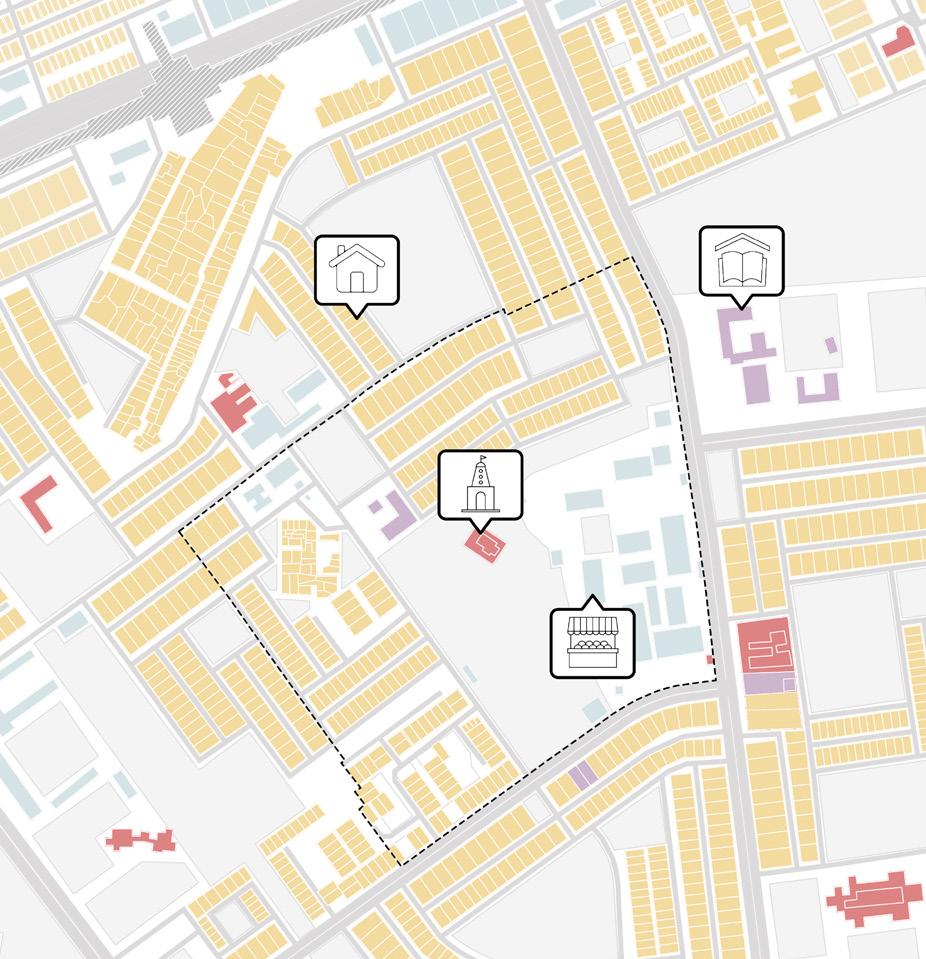
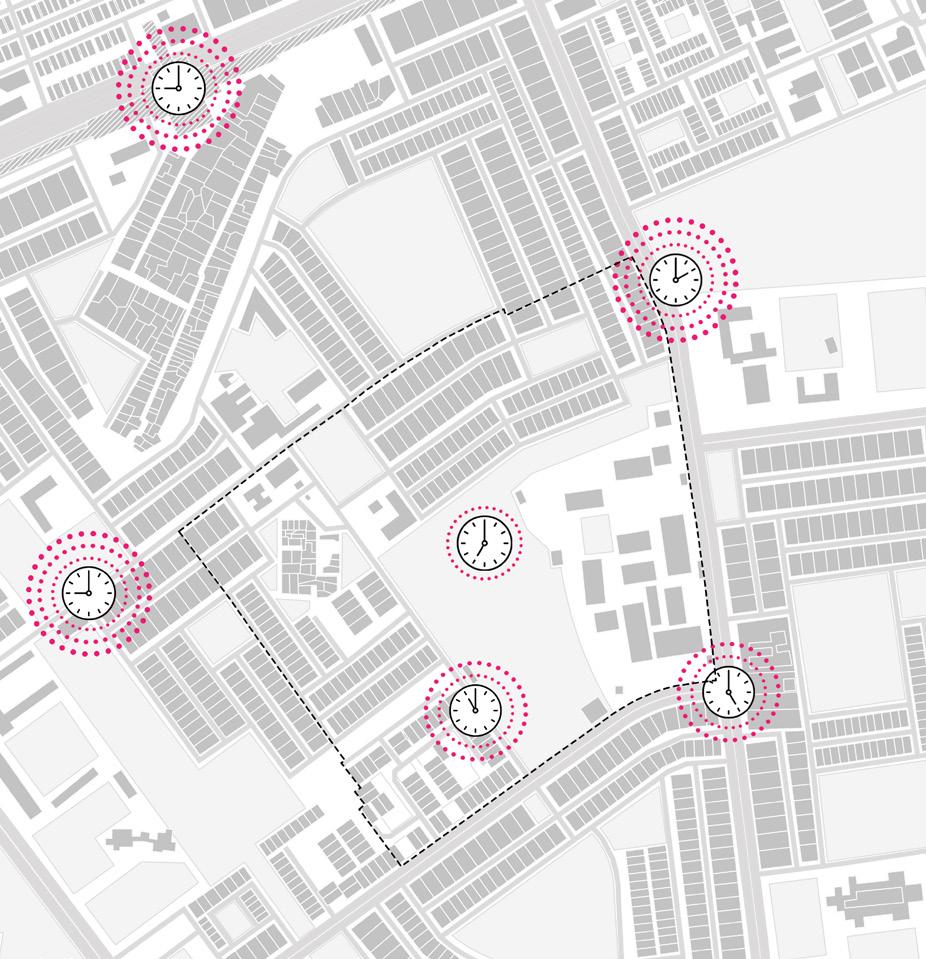


50
Connected podium level for relief on upper spaces but inward-looking blocks with unusable scale
Larger open space - extending the park into a plaza but created segregated zones of built-unbuilt





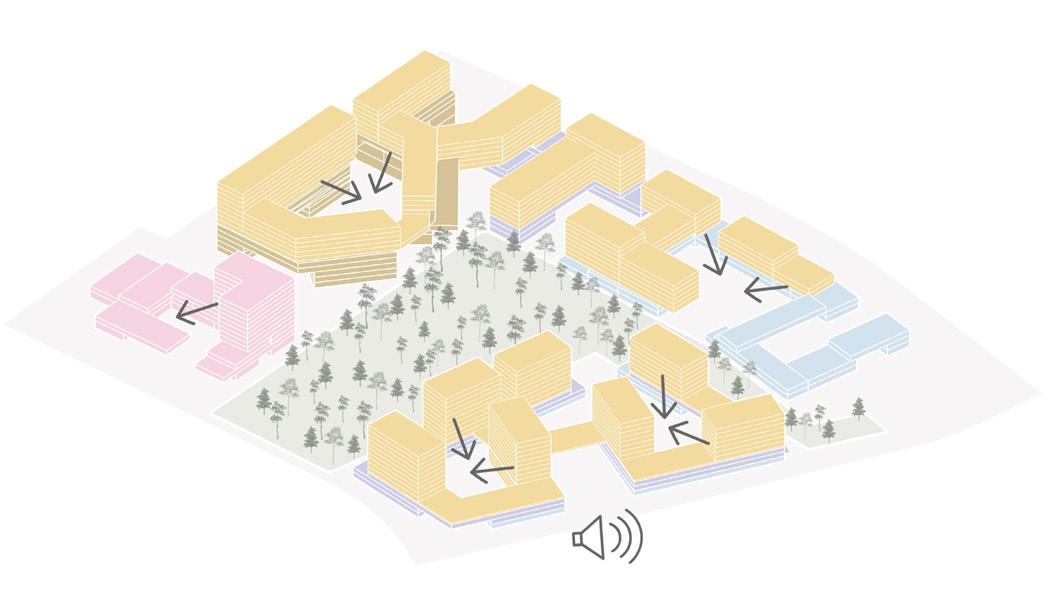
Zoning of hotel & commercial - act as noise buffers but park restricted by housing blocks
Shallow housing floor plate - cross ventilation across units but hotel rooms facing adjacent buildings
Porous build form allows central greens to ‘bleed out’ and connect with larger context
 Stage 1
Built around self shaded courtyards but housing adjacent to busy road
Stage 4
Stage 5
Stage 2
Stage 3
Stage 6
Stage 1
Built around self shaded courtyards but housing adjacent to busy road
Stage 4
Stage 5
Stage 2
Stage 3
Stage 6
Residential Social Facilities Hotel Offices Commercial


52 1 1 1 1 1 1 1 1 1 1 1 1 1 1 2 2 3 3 4 4 4 5 6 6 7 7 8 8 8 8 8 8 8 8 9 9 9 9 10 10 10 10 10 5 1. Site Entry 2. Public Park 3. Existing Temple 4. Retail Hub 5.Rentable Offices 6. Multiplex 7. Business Hotel 8. Mixed-Income Housing 9. Low-income housing 10. Community hall
Global move
Enabling the central park to remain accessible & visually connected
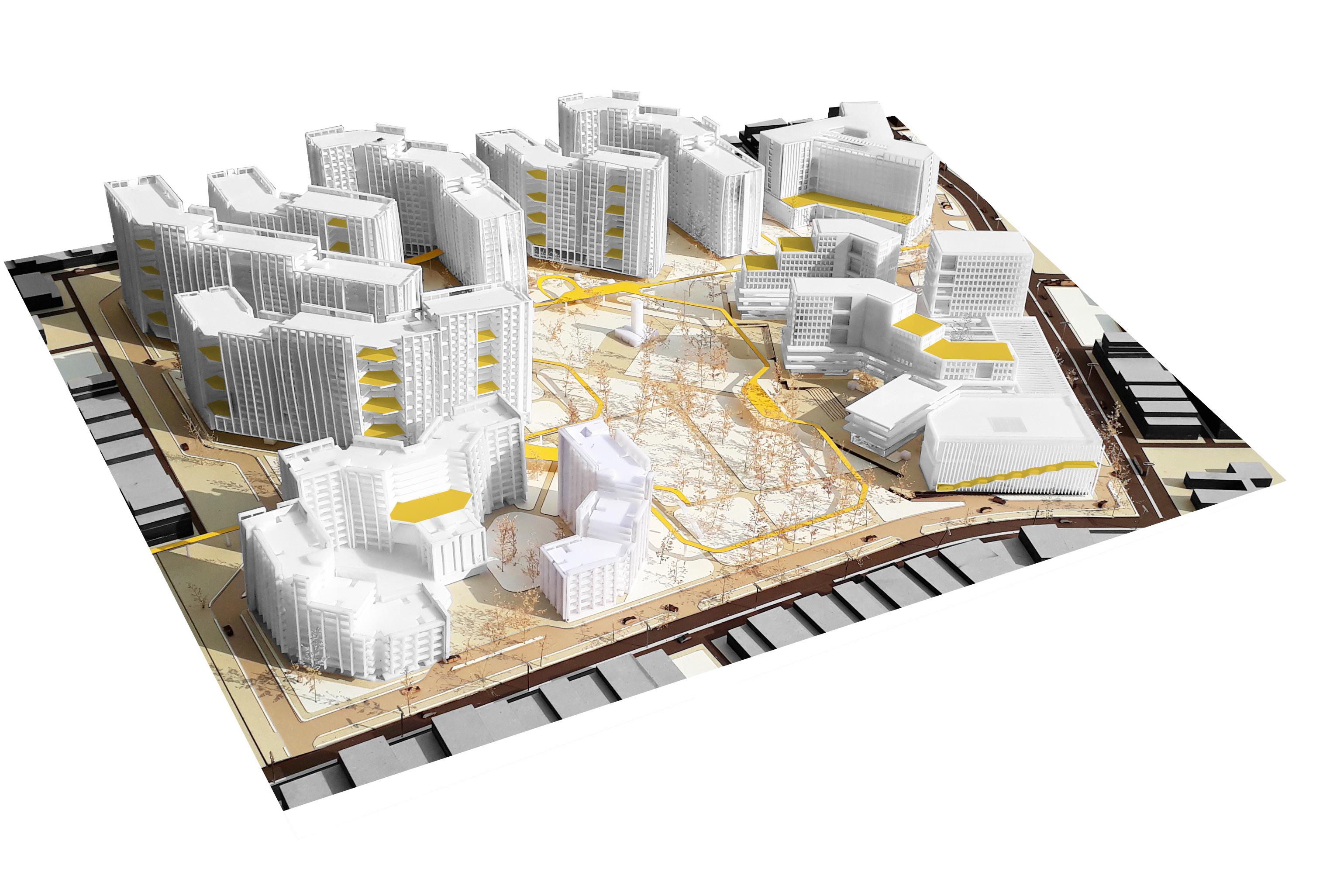
Parallel Bars

Inward Looking Courts
Sheltered yet Porous
Allows for movement, but no connection between blocks Shared space, yet allows movement & independence


Creates shared sense of place but not inviting
Pedestrian centric design
Car movement was restricted to the peripheries, while the bridge and terraces recreated elevated common spill-out spaces
Multi-Level site experiences for diverse user groups : Private experiences above, public thoroughfare below
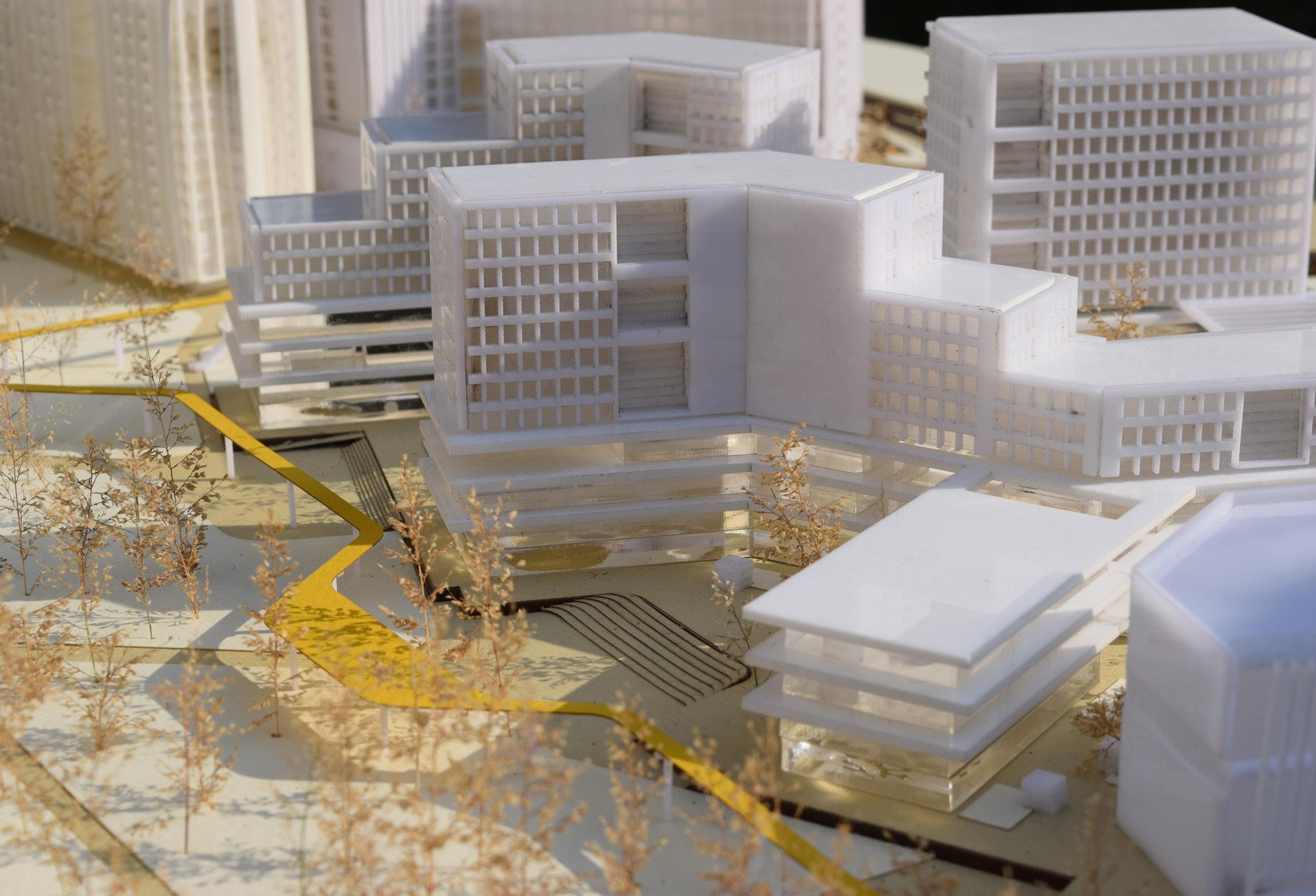


54
Framing urban vistas & extending the park
Porous site edges inviting the context
The elevated bridge creates a vehicular-free public realm while allowing space underneath for hosting informal markets & cycling tracks.

Academic
CAN A SINGLE DOOR LEAD TO MULTIPLE PATHS?
Located in a neglected neighborhood next to a busy thoroughfare, the interactive installation was proposed as an intervention for reactivating the public space.

Devised as frames within a frame, it allowed users to generate multiple iterative paths. This was symbolic of how everyone is capable of charting their own journeys, each story being unique and different.
Intentionally minimal in its outlook, the door in the middle of nowhere, was designed to intrigue the audience. Through the use of color, the intervention looked to attract users, allowing them to engage with the design.
HOW CAN ONE
BEYOND ARCHITECTURE?
Social resilience in post-disaster reconstruction
Published by the Journal of the (JIIA), this research paper studied of building social resilience through reconstruction. It led to an understanding technical skill, the process in which has a huge bearing on its impact the problems it looks to solve.
Project Role
Research | Writing | Editing section

Project Team
Anam Nasim | Sharon Sabu | Veeresh
56
Academic 2017
Installation for tactical urbanism
New Delhi
ONE ‘BUILD’ ARCHITECTURE?
reconstruction
Odisha
the Indian Institute of Architects studied the processes and ways through post-disaster housing understanding that apart from the which the project is undertaken impact and success at addressing
BESIDES PROJECTS ; REFLECTIONS ON PRACTICE

Designing a publication on Studio Lotus



New Delhi
Initiated a publication project to highlight the processes behind the projects, in an attempt to address common issues faced by practitioners. Through critical reflection, it aimed to showcase the workings of a contemporary design studio and address the reason and learnings from experiments, instead of just the finished products. A combination of key projects, interviews, and insights, it looked to narrate the development of the practice over 20 years.
Project Role
section on ‘Cyclones in Odisha’
Veeresh Angiras | Dr. Chaitali Basu
Curator & Editorial design | Project lead | Writing and drawing
Project Team
Mrinalini Ghadhiok (Editor) | Ananya Khaitan (Graphic Designer)
Professional 2022
2022
sharan.aniruddh10@gmail.com +91 8130036538 Questions & Ideas Graduate School Portfolio Aniruddh Sharan













 State of Indian Public Libraries
Changing models of Libraries
State of Indian Public Libraries
Changing models of Libraries










 Metro Station
Office Hub
Metro Station
Office Hub



 the
the



 Bridges fostering cross connections & dialogue
Bridges fostering cross connections & dialogue









 5. Skylight
2. Metal seamed roof
4. Steel structural framework
5. Skylight
2. Metal seamed roof
4. Steel structural framework




















 Drawn in collaboration with Prajwal Amin & Jatin Khandelwal
Drawn in collaboration with Prajwal Amin & Jatin Khandelwal














 1. Entrance Foyer
1. Entrance Foyer







 Paint chipped to highlight stone masonry
Paint chipped to highlight stone masonry










 Vernacular Section Heavy base & Cantilevering top
Interlocking Wood & Stone Kath-kuni construction
Section Iterations exploring User experiences
Metal columns & rafters Services
Glulam Timber columns & rafters
Vernacular Section Heavy base & Cantilevering top
Interlocking Wood & Stone Kath-kuni construction
Section Iterations exploring User experiences
Metal columns & rafters Services
Glulam Timber columns & rafters

 1. Reception
2. Bar & Lounge
3. Pool & smoke
4. Spa rooms
5. Gym & Games
6. Staircase
7. Room corridor
8. Pool deck
9. Heated pool
10. Landscape deck
11. Underfloor heating
12. MEP Services
13. Retaining wall passage
1. Reception
2. Bar & Lounge
3. Pool & smoke
4. Spa rooms
5. Gym & Games
6. Staircase
7. Room corridor
8. Pool deck
9. Heated pool
10. Landscape deck
11. Underfloor heating
12. MEP Services
13. Retaining wall passage











 Made in collaboration with Anam Nasim, Sharon Sabu, Veeresh Angiras
Made in collaboration with Anam Nasim, Sharon Sabu, Veeresh Angiras










 Stage 1
Built around self shaded courtyards but housing adjacent to busy road
Stage 4
Stage 5
Stage 2
Stage 3
Stage 6
Stage 1
Built around self shaded courtyards but housing adjacent to busy road
Stage 4
Stage 5
Stage 2
Stage 3
Stage 6















